Jack Ross's Blog, page 5
June 2, 2024
Memories of Gilbert & Sullivan
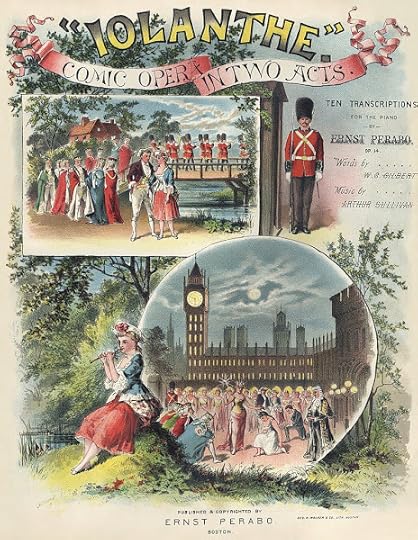 Gilbert & Sullivan: Iolanthe (1882)
Gilbert & Sullivan: Iolanthe (1882)Between 1976 and 1978, I was in the cast - that is to say, the chorus - of three Gilbert & Sullivan productions at my old High School, Rangitoto College. They were, in chronological order, Iolanthe , H.M.S. Pinafore , and The Gondoliers . I had a (very) small speaking part in the last of them.
 H.M.S. Pinafore (1878)
H.M.S. Pinafore (1878)To be honest, I was no great shakes as an actor or a singer, but I could hold a note and follow directions, and I turned up to all the rehearsals (including the weekend "Opera Camps" held for each production). The picture above should give you some idea of the kind of thing they were: a big stage, crowded with figures, with a few vague props and a backdrop.
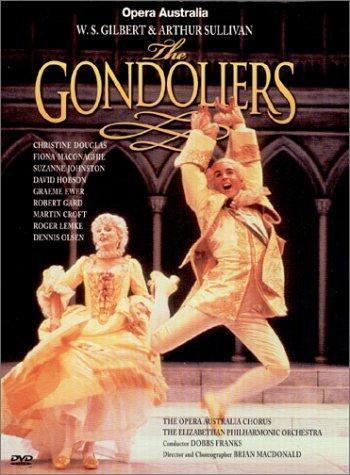 Gilbert & Sullivan: The Gondoliers (1882)
Gilbert & Sullivan: The Gondoliers (1882)Mrs. Zigliani was in charge of the music, and Mr. Carter (was it?) in charge of the acting and stagecraft. Both were inspirational figures - particularly the latter, who had a little group of (so-called) "drama sucks" who hung on his every word.
 Gilbert & Sullivan: The Pirates of Penzance (1879)
Gilbert & Sullivan: The Pirates of Penzance (1879)Years later, watching Tennessee Williams' The Glass Menagerie in yet another school production, I was very struck by the strange coincidences with my own family: the introverted Laura seemed a close fit with my sister Anne, the "gentleman caller" Jim O'Connor's past school triumphs as the Pirate King in The Pirates of Penzance matched up with my own brother Jim's success in the same role ...
 Tennessee Williams: The Glass Menagerie (1944)
Tennessee Williams: The Glass Menagerie (1944)What did it all mean? I'd never actually read Williams' play, so there was a strange, dislocating moment where I wondered if the director had rewritten it slightly for a local audience, as he was wont to do with the Gilbert & Sullivan operas. It soon became clear to me that that was not the case, but I still find that play bafflingly personal and - dare I say it? - prophetic of some of the stresses and strains, and future disappointments, in my own family.
That's probably the main flavour of these reminiscences, in fact. I remember mooning hopelessly, helplessly over the desperately glamorous girls from higher forms who took the main parts in the operas. And yet, when one of them spoke kindly to me when she found a copy of Marvell's poems I'd brought with me to rehearsal, I found myself quite unable to reply. I still writhe with embarassment every time my mind insists on re-enacting that scene, in fact.
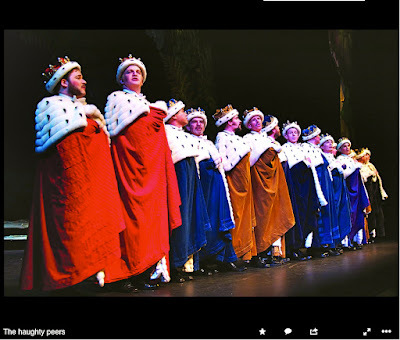 Gilbert & Sullivan: Chorus of Peers in Iolanthe
Gilbert & Sullivan: Chorus of Peers in IolantheWhat else has it left me? A few snatches of verse and tunes to hum in moments of stress:
I don't recall the rest of that one, but I seem to remember it ending up with the ingenious rhyme "House of Peers for House of Peri" - the male chorus of Iolanthe consisted of members of the House of Lords while the female chorus were all fairies (or "Peri", in Persian folklore).
He who shies
at such a prize
is not worth a maravedi! ...
There was also a splendid ballad halfway through the Opera where one of the principals described the vital necessity of retaining the Upper House of Parliament:
When Wellington beat Bonaparte
as every schoolboy knows
the House of Lords
all through the war
did nothing in particular
and did it very well ...
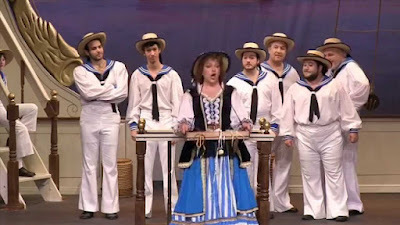 Gilbert & Sullivan: Little Buttercup & the Sailors in Pinafore
Gilbert & Sullivan: Little Buttercup & the Sailors in PinaforeH.M.S. Pinafore left me quite a bit more in the way of memories: for example, the following beautiful sample of Sullivan's more lyrical vein, sung by the unfortunate Captain Corcoran, who is (you'll recall) "never, never sick at sea":
And then there's this piece of crosstalk between Sir Joseph ("The ruler of the Queen's Navee"), the captain, the crew, and the redoubtable Little Buttercup:
Fair Moon, to thee I sing,
Bright regent of the heavens ...
I find, on consulting an online version of the text, that my recollections are pretty hazy and inaccurate. Never mind, I leave them as they stand, in the interests of adding verisimilitude to an otherwise bald and unconvincing narrative, to quote Pooh-Bah in The Mikado .
Sir Joseph:My pain and my surprise
you may guess from the expression of my eyes!
Chorus:How terrible the aspect of his eyes!
Buttercup:Ere upon this loss you lay much stress
a long forgotten crime I would confess:
A many years ago
when I was young and charming
as some of you may know
I practised baby-farming
Chorus:Oh this is most alarmingTwo tender babes I nussed
when she was young and charming
she practised baby-farming
a many years ago
one was of low condition
the other upper-crust
a regular patrician
Chorus:
So this is the position
one was of low condition
the other upper-crust
a regular patrician ... etc. etc.
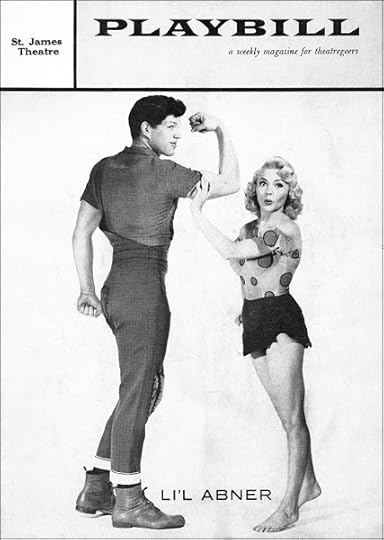 Li'l Abner (1956)
Li'l Abner (1956)The Gilbert & Sullivan team had had enough of pushing water uphill by the end of The Gondoliers, however, so another member of staff, Mr. Baumgart, offered to take up the baton. The musical he selected was Li'l Abner, however, and even though I was offered quite a meaty role in it, I somehow took it against this choice of entertainment.
Pure snobbery, no doubt - and I blush for it now, but the one thing I'll say for this rather peevish decision of mine is that it meant that I was finally able to sit in the audience for one of these productions. I have to say that it hugely amused and entertained - and the guy who ended up playing my role did a wonderful job, far better (probably) than I would have done myself.
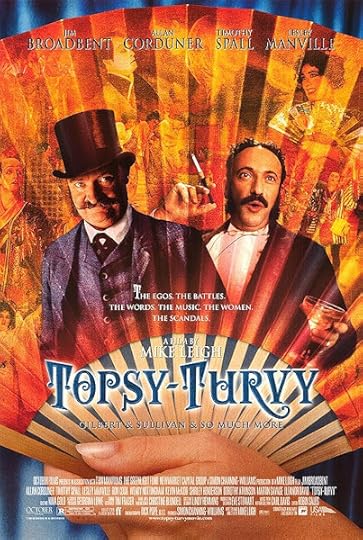 Mike Leigh, dir. Topsy-Turvy (1999)
Mike Leigh, dir. Topsy-Turvy (1999)I certainly don't regret spending so much time compulsorily immersing myself in W. S. Gilbert's famous "world of topsy-turvydom." It's one of those rare, incommunicable experiences - a little like being in a Shakespeare play, I suppose. The audience hopefully enjoys the end product more than the cast (it's not much of a production if they don't), but they can never really know the play in as much depth without having rehearsed and recited and stumbled over every line and bit of business.
Certainly being in some kind of a school dramatic production is seems like a necessary rite of passage. There was no way I would ever have had the skills to be in the chorus of West Side Story - another one of the plays they put on while I was there. For me, Gilbert & Sullivan was just the ticket.
You can find an (almost) complete list of Gilbert's plays here, at the Gilbert and Sullivan archive, along with a list of what Sullivan considered his more major works. I've listed below the books and editions by and about the pair which I myself have collected.
 Rangitoto College, East Coast Bays, Auckland
Rangitoto College, East Coast Bays, Auckland•
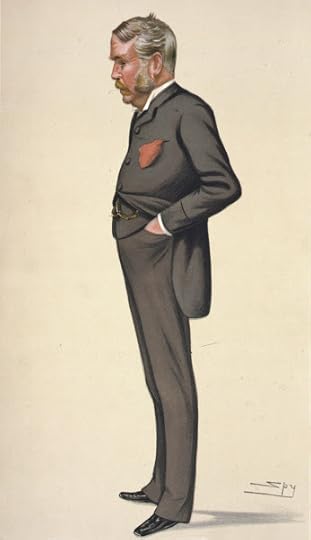 'Spy': W. S. Gilbert (1881)
'Spy': W. S. Gilbert (1881)Sir William Schwenck Gilbert
(1836–1911)
The Bab Ballads, with which are included Songs of a Savoyard. Illustrated by the Author. 1904. London: Macmillan & Co. Ltd. / New York: St. Martin’s Press, Inc., 1964.Original Plays. In Four Series. 4 vols. London: Chatto & Windus, 1911 & 1917.First Series: The Wicked World (1873); Pygmalion and Galatea (1871); Charity (1874); The Princess (1870); The Palace of Truth (1870); Trial by Jury (1875); Iolanthe (1882)Second Series: Broken Hearts (1875); Engaged (1877); Sweethearts (1874); Dan'l Druce, Blacksmith (1876); Gretchen (1879); Tom Cobb (1875); The Sorcerer (1877); H.M.S. Pinafore (1878); The Pirates of Penzance (1879)Third Series: Comedy and Tragedy (1884); Foggerty's Fairy (1881); Rosencrantz and Guildenstern (1874); Patience (1881); Princess Ida (1884); The Mikado (1885); Ruddigore (1887); The Yeomen of the Guard (1888); The Gondoliers (1889); Utopia, Limited (1893)Fourth Series: The Fairy's Dilemma (1904); The Grand Duke (1896); His Excellency (1894); "Haste to the Wedding" (1892); Fallen Fairies (1909); The Gentleman in Black (1870); Brantinghame Hall (1888); Creatures of Impulse (1871); Randall's Thumb (1871); The Fortune-Hunter (1897); Thespis (1871) The Plays & Poems of W. S. Gilbert: Including the Complete Text of the Fourteen Gilbert and Sullivan Operas, Three Other Gilbert Plays, and All the Bab Ballads. With Illustrations by the Author. [Thespis (1871); Trial by Jury (1875); The Sorcerer (1877); H.M.S. Pinafore (1878); The Pirates of Penzance (1879); Patience (1881); Iolanthe (1882); Princess Ida (1884); The Mikado (1885); Ruddigore (1887); The Yeomen of the Guard (1888); The Gondoliers (1889); Utopia Limited (1893); The Grand Duke (1896); with The Palace of Truth (1870); The Mountebanks (1892); His Excellency (1894)]. Preface by Deems Taylor. New York: Random House, 1932.Haining, Peter, ed. The Lost Stories of W. S. Gilbert. Illustrated by ‘Bab’. 1973. London: Robson Books Ltd., 1982.
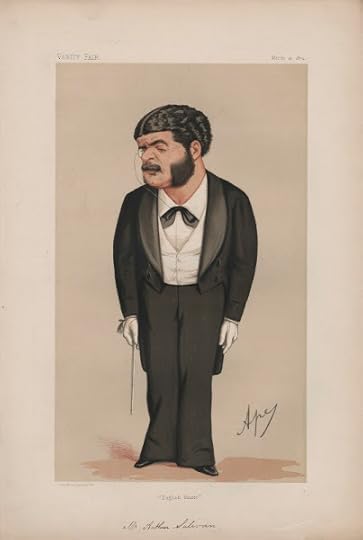 Carlo Pellegrini: Arthur Sullivan (1874)
Carlo Pellegrini: Arthur Sullivan (1874)Sir Arthur Seymour Sullivan
(1842–1900)
The Savoy Operas: Being the Complete Text of the Gilbert and Sullivan Operas as Originally Produced in the Years 1875-1896. 1926. London: Macmillan & Co., Limited, 1927.Bradley, Ian, ed. The Complete Annotated Gilbert and Sullivan [Trial by Jury (1875); The Sorcerer (1877); H.M.S. Pinafore (1878); The Pirates of Penzance (1879); Patience (1881); Iolanthe (1882); Princess Ida (1884); The Mikado (1885); Ruddigore (1887); The Yeomen of the Guard (1888); The Gondoliers (1889); Utopia Limited (1893); The Grand Duke (1896)]. 1982, 1984, 1996. Oxford: Oxford University Press, 2001.
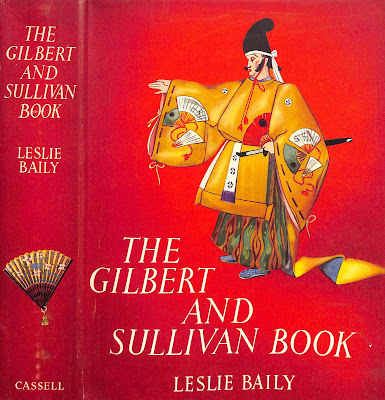 Leslie Baily: The Gilbert & Sullivan Book (1952)
Leslie Baily: The Gilbert & Sullivan Book (1952)Secondary:
Pearson, Hesketh. Gilbert and Sullivan: A Biography. 1935. Penguin Books, 791. Harmondsworth: Penguin / London: Hamish Hamilton Ltd., 1950.Baily, Leslie. The Gilbert & Sullivan Book: Revised Edition. 1952. London: Cassell & Company Ltd., 1956.Baily, Leslie. Gilbert & Sullivan and Their World. 1973. London: Book Club Associates / Thames and Hudson Ltd., 1974.
 Ian Bradley, ed.: The Complete Annotated Gilbert and Sullivan (2016)
Ian Bradley, ed.: The Complete Annotated Gilbert and Sullivan (2016)•
Published on June 02, 2024 16:42
May 25, 2024
SF Luminaries: Robert Silverberg
 Robert Silverberg (2005)
Robert Silverberg (2005)My PhD supervisor at the University of Edinburgh, Colin Manlove, a noted authority on Fantasy and SF, once told me that Robert Silverberg was his favourite writer in the genre, referring to him as 'the perfect Science Fiction machine.'
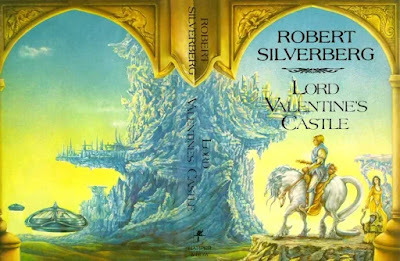 Robert Silverberg: Lord Valentine's Castle (1980)
Robert Silverberg: Lord Valentine's Castle (1980)Of course, that was back in the 1980s, shortly after Silverberg had staged a spectacular come-back, after a five year hiatus from fiction-writing, with Lord Valentine's Castle. But it was probably not such later works as the Majipoor series Colin had in mind so much as Silverberg's immense output as a Jack-of-all-trades pulp writer from the mid-1950s to roughly the mid-1970s.
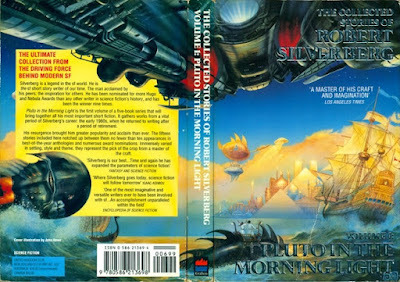 The Collected Stories of Robert Silverberg: Pluto in the Morning Light (1: 1992)
The Collected Stories of Robert Silverberg: Pluto in the Morning Light (1: 1992)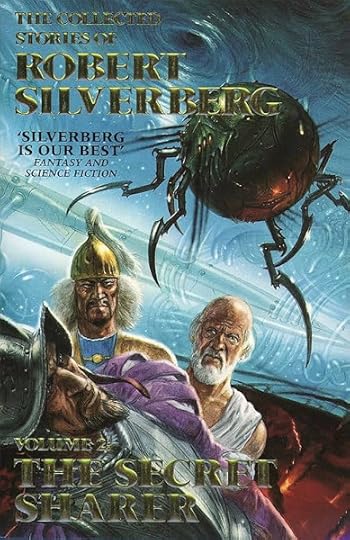 The Collected Stories of Robert Silverberg: The Secret Sharer (2: 1993)
The Collected Stories of Robert Silverberg: The Secret Sharer (2: 1993) The Collected Stories of Robert Silverberg (3-6: 1994-2000)
The Collected Stories of Robert Silverberg (3-6: 1994-2000)Recently I've been rereading all six volumes of The Collected Stories of Robert Silverberg issued by the HarperCollins UK imprint Voyager between 1992 and 2000. There's a couple of thousand pages of material in there, 106 stories in all - to which should be added another 16 collected in its immediate predecessor, The Conglomeroid Cocktail Party (1984). It ranges from a selection of his earliest magazine publications in the early 50s to his later work from the 80s and 90s.
 Robert Silverberg: Collected Stories (9 vols: 2006-14)
Robert Silverberg: Collected Stories (9 vols: 2006-14)Characteristically, though, Silverberg ultimately repudiated this series - which does, admittedly, range somewhat arbitrarily over time and space - in favour of an even more comprehensive assemblage, the 9-volume Collected Stories pictured above (you'll find further details in my somewhat SF-weighted attempt at a Silverberg bibliography below).
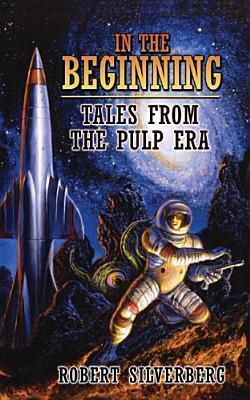 Robert Silverberg: In the Beginning: Tales from the Pulp Era (2006)
Robert Silverberg: In the Beginning: Tales from the Pulp Era (2006)Even this 9-volume, 151-story version (supplemented by another couple of volumes - 33 stories - of "Tales from the Pulp Era") is a mere selection from his actual production over this period, though.
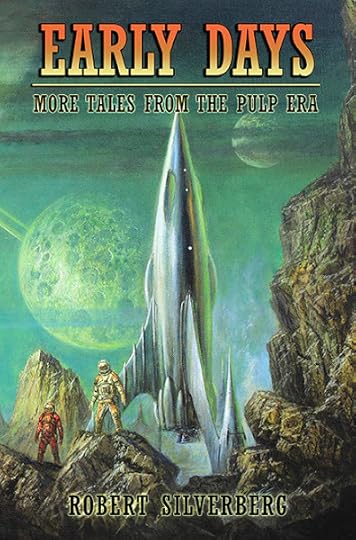 Robert Silverberg: Early Days: More Tales from the Pulp Era (2016)
Robert Silverberg: Early Days: More Tales from the Pulp Era (2016)So is "Robert Silverberg" just another version of Kurt Vonnegut's imaginary Kilgore Trout, a pulp-sci-fi-churning prodigy renowned for the quantity rather than the quality of his output? Readers who confined themselves solely to his early work might be forgiven for thinking so.
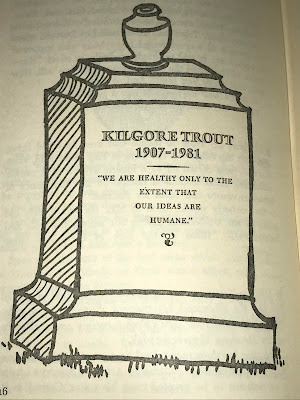 Reddit: Kilgore Trout Memorial (1907-1981)
Reddit: Kilgore Trout Memorial (1907-1981)I think what interested Colin Manlove most, though, were the insistent themes and motifs which recur throughout Silverberg's work, but particularly after the late 1960s: themes comparatively unusual for SF at the time, such as:the strong desire of so many of his protagonists to be subsumed in some sort of a cosmic all;a fascination with doubles and alternate selves;& a far greater preoccupation with sex (and gender politics generally) than previous SF writers had been allowed - or had allowed themselves - to explore.One could easily protract the list, but each of the three above could easily generate enough material for a critical monograph or (shudder) a Doctoral thesis ...
•
 Robert Silverberg: Gilgamesh the King (1984)
Robert Silverberg: Gilgamesh the King (1984)There is, however, another side to Robert Silverberg. From the early 1960s until roughly the mid-1970s he wrote an immense amount of non-fictional prose, focussing - for the most part - on subjects from archaeology and ancient history.
Many of these works remain worthwhile in themselves, but they also had the added advantage of opening up a new set of settings and ideas for his fictional work. His biographical novel Gilgamesh the King, for example, led directly to the afterlife story "Gilgamesh in the Outback", eventually collected in the novel-in-linked stories To the Land of the living (1990).
Roma Eterna, Sailing to Byzantium, Thebes of the Thousand Gates, and a number of his other novels and novellas are set either in ancient, or recreated alternative worlds of antiquity. His best-known and most popular series, the Majipoor books, are also heavily influenced by this atmosphere of antique immensity and imperial intrigue.
 Robert Silverberg: Great Adventures in Archaeology (1964)
Robert Silverberg: Great Adventures in Archaeology (1964)How, then, can we even start to sum up this most protean and prolific of SF writers? It's perhaps not so much that the sheer extent of his work defies categorisation and definition, as that that may not the most interesting way to read it.
These endless tallies of words published in a given year, fees earned from short-lived pulp magazines, emphases on his immense profligacy of invention are very much Silverberg's way of talking about himself.
It's better, then, to focus on the details: particular stories, particular visions - to give up trying to see him as a whole, but instead as a series of fractured parts. He is, after all, no Philip K. Dick. Unlike Dick, it's not in his overall themes he prevails but in the individual facets of his Balzacian overview of the human condition: past, present, and to come.
To start off with, you might try a couple of his later novels, the ones he published alongside the ongoing Majipoor Series about Lord Valentine and his successors (and predecessors). The Face of the Waters (1991) and Kingdoms of the Wall (1992) are two of my favourites: fascinating pieces of pure SF. However, if eco-fiction is more your thing, his 1994 novel Hot Sky at Midnight may seem startlingly prescient of our everyday climate woes right now.
One or other of his various assemblages of short stories is also a must-read. Only there can you get some sense of the prodigious energy and technical mastery which made him a legend among his peers - and, now, his successors.
 Robert Silverberg (1971)
Robert Silverberg (1971)•
 Internet Fiction Spéculative Base de Données: Robert Silverberg
Internet Fiction Spéculative Base de Données: Robert SilverbergRobert Silverberg
(1935- )
Books I own are marked in bold:Novels:
Revolt on Alpha C (1955)The 13th Immortal (1956)Master of Life and Death (1957)[with Randall Garrett, as Robert Randall] The Shrouded Planet (1957)Invaders from Earth (1958)[as Calvin M. Knox] Lest We Forget Thee, Earth (1958)Stepsons of Terra (1958)Stepsons of Terra. 1958. An Ace Science Fiction Book. New York: Ace Books, Inc., 1983. [as David Osborne] Aliens from Space (1958)[as David Osborne] Invisible Barriers (1958)[as Ivar Jorgenson] Starhaven (1958)Starman's Quest (1958)[as Calvin M. Knox] The Plot Against Earth (1959)[with Randall Garrett, as Robert Randall] The Dawning Light (1959)The Planet Killers (1959)Lost Race of Mars (1960)Collision Course (1961)The Seed of Earth (1962)Recalled to Life (1962) [Rev. ed. 1972]Blood on the Mink [aka 'Too Much Blood on the Mink'] (1962)The Silent Invaders (1963)Time of the Great Freeze (1964)Regan's Planet (1964)[as Calvin M. Knox] One of Our Asteroids is Missing (1964)Conquerors from the Darkness (1965)The Gate of Worlds (1967)Planet of Death (1967)Thorns (1967)Thorns. 1967. An Orbit Book. London: Futura Publications, 1987. Those Who Watch (1967)The Time Hoppers (1967)To Open the Sky (1967)To Open the Sky. 1967. Sphere Science Fiction. London: Sphere Books Ltd., 1977. The Man in the Maze (1968)The Man in the Maze. 1968. A Tandem Book. London: Tandem Publishing Ltd., 1977. Hawksbill Station (1968)Hawksbill Station. 1968. A Star Book. London: W. H. Allen & Co., Ltd., 1982. The Masks of Time (1968)Nightwings (1969)Nightwings. 1969. Sphere Science Fiction. London: Sphere Books Ltd., 1974. Across a Billion Years (1969)Three Survived (1969)To Live Again (1969)To Live Again. 1969. Fontana Science Fiction. London: Fontana/Collins, 1977. Up the Line (1969)Downward to the Earth (1970)Downward to the Earth. 1970. Pan Science Fiction. London: Pan Books, 1978. Tower of Glass (1970)Tower of Glass. 1970. Panther Science Fiction. Frogmore, St Albans, Herts: Granada Publishing Limited, 1976. World's Fair 1992 (1970)Son of Man (1971)Son of Man. 1971. Panther Science Fiction. Frogmore, St Albans, Herts: Granada Publishing Limited, 1979. The Second Trip (1971)The World Inside (1971)A Time of Changes (1971)A Time of Changes. 1971. Gollancz Classic SF, 3. London: Victor Gollancz Ltd, 1986. The Book of Skulls (1971)The Book of Skulls. 1972. Coronet Books. London: Hodder & Stoughton Paperbacks, 1981. Dying Inside (1972)Dying Inside. 1972. VGSF Classics, 31. London: Victor Gollancz Ltd., 1989. The Stochastic Man (1975)Shadrach in the Furnace (1976)Homefaring (1982)Lord of Darkness (1983)Gilgamesh the King (1984)Gilgamesh the King. New York: Arbor House, 1984. Sailing to Byzantium (1985)Tom O'Bedlam (1985)Tom O'Bedlam. 1985. An Orbit Book. London: Futura Publications, 1987. Star of Gypsies (1986)Star of Gypsies. 1986. An Orbit Book. London: Futura Publications, 1988. At Winter's End (1988)At Winter's End. 1988. A Legend Book. London: Arrow Books limited, 1990. Project Pendulum (1989)Letters From Atlantis (1990)The New Springtime [aka 'The Queen of Springtime'] (1990)The Queen of Springtime. 1989. A Legend Book. London: Arrow Books limited, 1991. To the Land of the Living (1990)To the Land of the Living. 1990. VGSF. London: Victor Gollancz Ltd., 1990. [with Isaac Asimov, based on his 1941 story] Nightfall (1990)Thebes of the Hundred Gates (1991)Thebes of the Hundred Gates. 1991. HarperCollins Science Fiction and Fantasy. London: HarperCollins Publishers Ltd., 1994. The Face of the Waters (1991)The Face of the Waters. 1991. A Bantam Spectra Book. New York: Bantam Books, 1992. [with Isaac Asimov, based on his story 'Lastborn' (1958)] Child of Time [aka 'The Ugly Little Boy'] (1991)Kingdoms of the Wall (1992)Kingdoms of the Wall. 1992. Grafton. London: HarperCollins Publishers, 1993. [with Isaac Asimov, based on his story 'The Bicentennial Man' (1976)] The Positronic Man (1992)Hot Sky at Midnight (1994)Hot Sky at Midnight. 1994. A Bantam Spectra Book. New York: Bantam Books, 1995. Starborne (1996)The Alien Years (1998)The Longest Way Home (2002)The Longest Way Home. Gollancz. London: Orion Publishing Group, 2002. Roma Eterna (2003)Roma Eterna. Gollancz. London: Orion Publishing Group, 2003. The Last Song of Orpheus (2010)
Majipoor:
Lord Valentine's Castle (1980)Lord Valentine's Castle. 1980. London: Pan Books, 1981. Majipoor Chronicles (1982)Majipoor Chronicles. 1982. London: Pan Books, 1983. Valentine Pontifex (1983)Valentine Pontifex. 1983. London: Pan Books, 1985. The Mountains of Majipoor (1995)The Mountains of Majipoor. London: Pan Books, 1995. Sorcerers of Majipoor (1997)Sorcerers of Majipoor. London: Pan Books, 1997. Lord Prestimion (1999)Lord Prestimion. Voyager. London: HarperCollins Publishers, 1999. King of Dreams (2001)The King of Dreams. 2001. Voyager. London: HarperCollins Publishers, 2002. Tales of Majipoor (2013)Tales of Majipoor. Gollancz. London: Orion Publishing Group, 2013.
Short Stories:
Next Stop, the Stars (1962)Godling, Go Home (1964)Needle in a Timestack (1966)The Calibrated Alligator (1969)Dimension Thirteen (1969)The Cube Root of Uncertainty (1970)Parsecs and Parables (1973)Moonferns & Starsongs (1971)The Reality Trip and Other Implausibilities (1972)Valley Beyond Time (1973)Earth's Other Shadow (1973)Unfamiliar Territory (1973) [Unfamiliar]Caught in the Organ Draft (1972){Now + n, Now - n} (1972)Some Notes on the Pre-Dynastic Epoch (1973)In the Group (1973)Caliban (1972)Many Mansions (1973)Good News from the Vatican (1971)Push No More (1972)The Mutant Season (1973)When We Went to See the End of the World (1972)What We Learned from This Morning's Newspaper (1972)In Entropy's Jaws (1971)The Wind and the Rain (1973) Unfamiliar Territory. 1973. Coronet Books. London: Hodder & Stoughton Paperbacks, 1981. The Feast of St. Dionysus: Five Science Fiction Stories (1975)Sunrise on Mercury (1975)Capricorn Games (1976)The Best of Robert Silverberg (1976) [Best]Barry N. Malzberg: Thinking About Silverberg (1976)
Robert Silverberg: Introduction (1976)Road to Nightfall (1958)Warm Man (1957)To See the Invisible Man (1963)The Sixth Palace (1965)Flies (1967)Hawksbill Station (1967)Passengers (1968)Nightwings (1968)Sundance (1969)Good News from the Vatican (1971) The Best of Robert Silverberg. 1976. An Orbit Book. London: Futura Publications, 1978. The Shores of Tomorrow (1976)World of a Thousand Colors (1982)The Conglomeroid Cocktail Party (1984) [Conglomeroid]Robert Silverberg: Introduction (1984)The Far Side of the Bell-Shaped Curve (1982)The Pope of the Chimps (1982)The Changeling (1982)The Man Who Floated in Time (1982)The Palace at Midnight (1981)A Thousand Paces Along the Via Dolorosa (1981)At the Conglomeroid Cocktail Party (1982)Our Lady of the Sauropods (1980)Gianni (1982)The Trouble with Sempoanga (1982)How They Pass the Time in Pelpel (1981)Waiting for the Earthquake (1981)Not Our Brother (1982)The Regulars (1981)Jennifer's Lover (1982)Needle in a Timestack (1983) The Conglomeroid Cocktail Party. 1984. VGSF. London: Victor Gollancz Ltd., 1989. Beyond the Safe Zone (1986)The Collected Stories of Robert Silverberg. 6 vols (1992-2000):Pluto in the Morning Light (1992) [1: Pluto]Robert Silverberg: Introduction (1992)Homefaring (1983)Basileus (1983)Dancers in the Time-Flux (1983)Gate of Horn, Gate of Ivory (1984)Amanda and the Alien (1983)Snake and Ocean, Ocean and Snake [aka 'The Affair'] (1984)Tourist Trade (1984)Multiples (1983)Against Babylon (1986)Symbiont (1985)Sailing to Byzantium (1985)Sunrise on Pluto (1985)Hardware (1987)Hannibal's Elephants (1988)Blindsight (1986) The Collected Stories of Robert Silverberg. Volume 1: Pluto in the Morning Light. Grafton. London: HarperCollins Publishers, 1992. The Secret Sharer (1993) [2: Secret]Robert Silverberg: Introduction (1993)The Pardoner's Tale (1987)The Iron Star (1987)The Secret Sharer (1987)House of Bones (1988)The Dead Man's Eyes (1988)Chip Runner (1989)To the Promised Land (1989)The Asenion Solution (1989)A Sleep and a Forgetting (1989)Enter a Soldier. Later: Enter Another (1989)We Are for the Dark (1988) The Collected Stories of Robert Silverberg. Volume 2: The Secret Sharer. Grafton. London: HarperCollins Publishers, 1993. Beyond the Safe Zone (1994) [3: Beyond]Robert Silverberg: Introduction (1994)Capricorn Games (1974)The Dybbuk of Mazel Tov IV (1974)Trips (1974)Schwartz Between the Galaxies (1974)Many Mansions (1973)Good News from the Vatican (1971)In the Group (1973)The Feast of St. Dionysus (1973)Caught in the Organ Draft (1972){Now + n, Now - n} (1972)Caliban (1972)Getting Across (1973)Breckenridge and the Continuum (1973)In the House of Double Minds (1974)The Science Fiction Hall of Fame (1973)The Wind and the Rain (1973)A Sea of Faces (1974)What We Learned from This Morning's Newspaper (1972)Ship-Sister, Star-Sister (1973)When We Went to See the End of the World (1972)Push No More (1972)Some Notes on the Pre-Dynastic Epoch (1973)In Entropy's Jaws (1971)Ms. Found in an Abandoned Time Machine (1973)The Mutant Season (1973)This Is the Road (1973) The Collected Stories of Robert Silverberg. Volume 3: Beyond the Safe Zone. Science Fiction & Fantasy. London: HarperCollins Publishers, 1994. The Road to Nightfall (1996) [4: Nightfall]Robert Silverberg: Introduction (1996)Road to Nightfall (1958)Gorgon Planet (1954)The Silent Colony (1954)Absolutely Inflexible (1956)The Macauley Circuit (1956)The Songs of Summer (1956)Alaree (1958)The Artifact Business (1957)Collecting Team (1956)A Man of Talent (1966)One-Way Journey (1957)Sunrise on Mercury (1957)World of a Thousand Colours (1957)Warm Man (1957)Blaze of Glory (1957)Why? (1957)The Outbreeders (1959)The Man Who Never Forgot (1958)There Was an Old Woman (1958)The Iron Chancellor (1958)Ozymandias (1958) The Collected Stories of Robert Silverberg. Volume 4: The Road to Nightfall. Voyager. London: HarperCollins Publishers, 1996. Ringing the Changes (1997) [5: Ringing]Robert Silverberg: Introduction (1997)To See the Invisible Man (1963)The Pain Peddlers (1963)Neighbor (1964)The Sixth Palace (1965)Flies (1967)Halfway House (1966)To the Dark Star (1968)Passengers (1968)Bride 91 [aka 'Bride Ninety-One'] (1967)Going Down Smooth (1968)Fangs of the Trees (1968)Ishmael in Love (1970)Ringing the Changes (1970)Sundance (1969)How It Was When the Past Went Away (1969)After the Myths Went Home (1969)The Pleasure of Their Company (1970)We Know Who We Are (1970)Something Wild Is Loose (1971)The Reality Trip (1970) The Collected Stories of Robert Silverberg. Volume 5: Ringing the Changes. Voyager. London: HarperCollins Publishers, 1997. Lion Time in Timbuctoo (2000) [6: Lion]Robert Silverberg: Introduction (2000)Lion Time in Timbuctoo (1990)A Tip on a Turtle (1991)In the Clone Zone (1991)Hunters in the Forest (1991)A Long Night's Vigil at the Temple (1992)It Comes and Goes (1992)Looking for the Fountain (1992)The Way to Spook City (1992)The Red Blaze Is the Morning (1995)Death Do Us Part (1996)The Martian Invasion Journals of Henry James (1996)Crossing Into the Empire (1996)The Second Shield (1995) The Collected Stories of Robert Silverberg. Volume 6: Lion Time in Timbuctoo. Voyager. London: HarperCollins Publishers, 2000. Phases of the Moon (2004)Tales from the Pulp Era. 2 vols (2006-2016):In the Beginning: Tales from the Pulp Era (2006)Robert Silverberg: Introduction (2006)Yokel with Portfolio (1955)Long Live the Kejwa (1956)Guardian of the Crystal Gate (1956)Choke Chain (1956)Citadel of Darkness (1957)Cosmic Kill (1957)New Year's Eve — 2000 A.D.? (1957)The Android Kill (1957)The Hunters of Cutwold (1957)Come Into My Brain! (1958)Castaways of Space (1958)Exiled From Earth (1958)Second Start (1959)Mournful Monster (1959)Vampires from Outer Space (1959)The Insidious Invaders (1959) Early Days: More Tales from the Pulp Era (2016)Robert Silverberg: Introduction (2016)The Inquisitor (1956)The Ultimate Weapon (1957)Harwood's Vortex (1957)Quick Freeze (1957)Six Frightened Men (1957)Puppets Without Strings [aka 'Call Me Zombie!'] (1957)A Time for Revenge (1957)Housemaid No. 103 (1957)Rescue Mission (1957)Planet of Parasites (1958)Slaves of the Tree (1958)Frontier Planet (1958)The Aliens Were Haters (1958)The Traders [aka 'The Unique and Terrible Compulsion'] (1958)Waters of Forgetfulness (1959)You Do Something to Me (1959)There's No Place Like Space! (1959) The Collected Stories. 9 vols (2006-2014):To Be Continued: 1954-59. The Collected Stories, 1 (2006)Robert Silverberg: Introduction (2006)Gorgon Planet (1954) [4: Nightfall]The Road to Nightfall (1958) [Best] [4: Nightfall]The Silent Colony (1954) [4: Nightfall]Absolutely Inflexible (1956) [4: Nightfall]The Macauley Circuit (1956) [4: Nightfall]The Songs of Summer (1956) [4: Nightfall]To Be Continued (1956)Alaree (1958) [4: Nightfall]The Artifact Business (1957) [4: Nightfall]Collecting Team (1956) [4: Nightfall]A Man of Talent (1956/66) [4: Nightfall]One-Way Journey (1957) [4: Nightfall]Sunrise on Mercury (1957) [4: Nightfall]World of a Thousand Colors (1957) [4: Nightfall]Warm Man (1957) [Best] [4: Nightfall]Blaze of Glory (1957) [4: Nightfall]Why? (1957) [4: Nightfall]The Outbreeders (1959) [4: Nightfall]The Man Who Never Forgot (1958) [4: Nightfall]There Was an Old Woman (1958) [4: Nightfall]The Iron Chancellor (1958) [4: Nightfall]Ozymandias (1958) [4: Nightfall]Counterpart (1959)Delivery Guaranteed (1959) To the Dark Star: 1962-69. The Collected Stories, 2 (2007)Robert Silverberg: Introduction (2007)To See the Invisible Man (1963) [Best] [5: Ringing]The Pain Peddlers (1963) [5: Ringing]Neighbor (1964) [5: Ringing]The Sixth Palace (1965) [Best] [5: Ringing]Flies (1967) [Best] [5: Ringing]Halfway House (1966) [5: Ringing]To the Dark Star (1968) [5: Ringing]Hawksbill Station (1967) [Best]Passengers (1968) [Best] [5: Ringing]Bride 91 (1967) [5: Ringing]Going Down Smooth (1968) [5: Ringing]The Fangs of the Trees (1968) [5: Ringing]Ishmael in Love (1970) [5: Ringing]Ringing the Changes (1970) [5: Ringing]Sundance (1969) [Best] [5: Ringing]How It Was When the Past Went Away (1969) [5: Ringing]A Happy Day in 2381 (1970)(Now + n, Now - n) (1972) [Unfamiliar] [3: Beyond]After the Myths Went Home (1969) [5: Ringing]The Pleasure of Their Company (1970) [5: Ringing]We Know Who We Are (1970) [5: Ringing] Something Wild Is Loose: 1969-72. The Collected Stories, 3 (2008)Robert Silverberg: Introduction (2008)Something Wild Is Loose (1971) [5: Ringing]In Entropy's Jaws (1971) [Unfamiliar] [3: Beyond]The Reality Trip (1970) [5: Ringing]Going (1971)Caliban (1972) [Unfamiliar] [3: Beyond]Good News from the Vatican (1971) [Unfamiliar] [Best] [3: Beyond]Thomas the Proclaimer (1972)When We Went to See the End of the World (1972) [Unfamiliar] [3: Beyond]Push No More (1972) [Unfamiliar] [3: Beyond]The Wind and the Rain (1973) [Unfamiliar] [3: Beyond]Some Notes on the Pre-Dynastic Epoch (1973) [Unfamiliar] [3: Beyond]The Feast of St. Dionysus (1973) [3: Beyond]What We Learned from This Morning's Newspaper (1972) [Unfamiliar] [3: Beyond]The Mutant Season (1973) [Unfamiliar] [3: Beyond]Caught in the Organ Draft (1972) [Unfamiliar] [3: Beyond]Many Mansions (1973) [Unfamiliar] [3: Beyond] Trips: 1972-73. The Collected Stories, 4 (2009)Robert Silverberg: Introduction (2009)In the Group (1973) [Unfamiliar] [3: Beyond]Getting Across (1973) [3: Beyond]Ms. Found in an Abandoned Time Machine (1973) [3: Beyond]The Science Fiction Hall of Fame (1973) [3: Beyond]A Sea of Faces (1974) [3: Beyond]The Dybbuk of Mazel Tov IV (1974) [3: Beyond]Breckenridge and the Continuum (1973) [3: Beyond]Capricorn Games (1974) [3: Beyond]Ship-Sister, Star-Sister (1973) [3: Beyond]This Is the Road (1973) [3: Beyond]Trips (1974) [3: Beyond]Born with the Dead (1974)Schwartz Between the Galaxies (1974) [3: Beyond]In the House of Double Minds (1974) [3: Beyond] The Palace at Midnight: 1980-82. The Collected Stories, 5 (2010)Robert Silverberg: Introduction (2010)Our Lady of the Sauropods (1980) [Conglomeroid]Waiting for the Earthquake (1981) [Conglomeroid]The Regulars (1981) [Conglomeroid]The Far Side of the Bell-Shaped Curve (1982) [Conglomeroid]A Thousand Paces Along the Via Dolorosa (1981) [Conglomeroid]How They Pass the Time in Pelpel (1981) [Conglomeroid]The Palace at Midnight (1981) [Conglomeroid]The Man Who Floated in Time (1982) [Conglomeroid]Gianni (1982) [Conglomeroid]The Pope of the Chimps (1982) [Conglomeroid]Thesme and the Ghayrog (1982)At the Conglomeroid Cocktail Party (1982) [Conglomeroid]The Trouble with Sempoanga (1982) [Conglomeroid]Jennifer's Lover (1982) [Conglomeroid]Not Our Brother (1982) [Conglomeroid]Gate of Horn, Gate of Ivory (1984) [1: Pluto]Dancers in the Time-Flux (1983) [1: Pluto]Needle in a Timestack (1983) [Conglomeroid]Amanda and the Alien (1983) [1: Pluto]Snake and Ocean, Ocean and Snake (1984) [1: Pluto]The Changeling (1982) [Conglomeroid]Basileus (1983) [1: Pluto]Homefaring (1983) [1: Pluto] Multiples: 1983-87. The Collected Stories, 6 (2011)Robert Silverberg: Introduction (2011)Tourist Trade (1984) [1: Pluto]Multiples (1983) [1: Pluto]Against Babylon (1986) [1: Pluto]Symbiont (1985) [1: Pluto]Sailing to Byzantium (1985) [1: Pluto]Sunrise on Pluto (1985) [1: Pluto]Hardware (1987) [1: Pluto]Hannibal's Elephants (1988) [1: Pluto]Blindsight (1986) [1: Pluto]Gilgamesh in the Outback (1986)The Pardoner's Tale (1987) [2: Secret]The Iron Star (1987) [2: Secret]The Secret Sharer (1987) [2: Secret]House of Bones (1988) [2: Secret] We Are for the Dark: 1987-90. The Collected Stories, 7 (2012)Robert Silverberg: Introduction (2012)The Dead Man's Eyes (1988) [2: Secret]Enter a Soldier. Later: Enter Another (1989) [2: Secret]To the Promised Land (1989) [2: Secret]Chip Runner (1989) [2: Secret]A Sleep and a Forgetting (1989) [2: Secret]In Another Country (1989)The Asenion Solution (1989) [2: Secret]We Are for the Dark (1988) [2: Secret]Lion Time in Timbuctoo (1990) [6: Lion]A Tip on a Turtle (1991) [6: Lion] Hot Times in Magma City: 1990-95. The Collected Stories, 8 (2013)Robert Silverberg: Introduction (2013)In the Clone Zone (1991) [6: Lion]Hunters in the Forest (1991) [6: Lion]A Long Night's Vigil at the Temple (1992) [6: Lion]Thebes of the Hundred Gates • (1992)It Comes and Goes (1992) [6: Lion]Looking for the Fountain (1992) [6: Lion]The Way to Spook City (1992) [6: Lion]The Red Blaze Is the Morning (1995) [6: Lion]Death Do Us Part (1996) [6: Lion]The Martian Invasion Journals of Henry James (1996) [6: Lion]Crossing Into the Empire (1996) [6: Lion]The Second Shield (1995) [6: Lion]Hot Times in Magma City (1995) The Millennium Express: 1995-2009. The Collected Stories, 9 (2014)Robert Silverberg: Introduction (2014)Diana of the Hundred Breasts (1996)Beauty in the Night (1997)Call Me Titan (1997)The Tree That Grew from the Sky (1996)The Church at Monte Saturno (1997)Hanosz Prime Goes to Old Earth (2006)The Millennium Express (2000)Travelers (1999)The Colonel Returns to the Stars (2004)The Eater of Dreams (2007)A Piece of the Great World (2005)Against the Current (2007)The True Vintage of Erzuine Thale (2009)Defenders of the Frontier (2010)The Prisoner (2010)Smithers and the Ghosts of the Thar (2011) [with Randall Garrett] A Little Intelligence (2009)
Non-fiction:
Treasures Beneath the Sea. Illustrated by Norman Kenyon (1960)[as Edgar Black] Sir Winston Churchill: The Compelling Life Story of one of the Towering Figures of the 20th Century (1961)First American into Space (1961)Lost Cities and Vanished Civilizations (1962)[as Walter Drummond] Philosopher of Evil (1962)The Fabulous Rockefellers (1963)Sunken History: The Story of Underwater Archaeology (1963)[as Walter Drummond] How to Spend Money (1963)Fifteen Battles that Changed the World (1963)Empires in the Dust: Ancient Civilizations Brought to Light (1963)Home of the Red Man: Indian North America before Columbus (1963)[as L. T. Woodward] The History of Surgery (1963)The Great Doctors (1964)Man Before Adam: The Story of Man in Search of His Origins (1964)Akhnaten: The Rebel Pharaoh (1964)[as Franklin Hamilton] 1066 (1964)[as Walker Chapman] The Loneliest Continent: The Story of Antarctic Discovery (1964)The Man Who Found Nineveh: The Story of Austen Henry Layard (1964)Great Adventures in Archaeology: From Belzoni to Woolley. 1964. Harmondsworth: Penguin, 1985.Socrates (1965)Scientists And Scoundrels: A Book of Hoaxes (1965)Men Who Mastered the Atom (1965)Niels Bohr: The Man Who Mapped the Atom (1965)The Old Ones: Indians of the American Southwest (1965)The Great Wall of China (1965)The World of Coral (1965)[as Franklin Hamilton] The Crusades (1965, )[as Walker Chapman] Antarctic Conquest: The Great Explorers in Their Own Words (1966)The Long Rampart: The Story of the Great Wall of China (1966)[as Lee Sebastian] Rivers: A Book to Begin On (1966)Forgotten by Time: A Book of Living Fossils (1966)Frontiers in Archeology (1966)[as Walker Chapman] Kublai Khan: Lord of Xanadu (1966)[as Roy Cook] Leaders Of Labor (1966)Bridges (1966)To the Rock of Darius: The Story of Henry Rawlinson (1966)[as Lloyd Robinson] The Hopefuls: Ten Presidential Campaigns (1966)The Morning of Mankind: Prehistoric Man in Europe (1967)[as Walker Chapman] The Golden Dream: Seekers of El Dorado (1967)The Auk, the Dodo and the Oryx (1967)The World of the Rain Forests (1967)The Dawn of Medicine (1967)The Adventures of Nat Palmer (1967)[as Franklin Hamilton] Challenge for a Throne: The Wars of the Roses (1967)Men Against Time: Salvage Archeology in the United States (1967)Light for the World: Edison and the Power Industry (1967)[as Walker Chapman] The Search for Eldorado (1967)[as L. T. Woodward] Sophisticated Sex Techniques in Marriage (1967)Mound Builders of Ancient America: The Archeology of a Myth (1968)The World of the Ocean Depths (1968)[as Lloyd Robinson] The Stolen Election: Hayes vs. Tilden, 1876 (1968)Four Men Who Changed the Universe (1968)[as Paul Hollander] Sam Houston (1968)[as Lee Sebastian] The South Pole: A Book to Begin On (1968)Stormy Voyager (1968)Ghost Towns of the American West (1968)Vanishing Giants: The Story of the Sequoias (1969)Wonders of Ancient Chinese Science (1969)The Challenge of Climate: Man and His Environment (1969)Bruce of the Blue Nile (1969)The World of Space (1969)If I Forget Thee, O Jerusalem (1970)The Seven Wonders of the Ancient World (1970)Mammoths, Mastodons and Man (1970)The Mound Builders (1970)The Pueblo Revolt (1970)Clocks for the Ages: How Scientists Date the Past (1971)To The Western Shore: Growth of the United States 1776-1853 (1971)Before The Sphinx: Early Egypt (1971)[with Arthur C. Clarke] Into Space: A Young Person's Guide to Space (1971)The Realm of Prester John (1972)The Longest Voyage: Circumnavigation in the Age Of Discovery (1972)John Muir, Prophet Among the Glaciers (1972)The World Within the Ocean Wave (1972)The World Within the Tide Pool (1972)Drug Themes in Science Fiction (1974)Reflections and Refractions: Thoughts on Science Fiction, Science and Other Matters (1997) [Rev. ed. 2016]Musings and Meditations (2011)
Edited:
Earthmen & Strangers (1966)Voyagers in Time (1967)AlphaAlpha 1 (1970)Alpha 2 (1971)Alpha 3 (1972)Alpha 4 (1973)Alpha 5 (1974)Alpha 6 (1976)Alpha 7 (1977)Alpha 8 (1977)Alpha 9 (1978) The Science Fiction Hall of FameVolume One, 1929–1964 (1970)Volume Two (1973) [with Roger Zelazny & James Blish] Three For Tomorrow. Foreword by Arthur C. Clarke (1970)New DimensionsNew Dimensions 1 (1971)New Dimensions II (1972)New Dimensions 3 (1973)New Dimensions IV (1974)New Dimensions Science Fiction 5 (1975)New Dimensions Science Fiction 6 (1976)New Dimensions Science Fiction 7 (1977)New Dimensions Science Fiction 8 (1978)New Dimensions Science Fiction 9 (1979)New Dimensions Science Fiction 10 (1980)[with Marta Randall] New Dimensions 11 (1980)[with Marta Randall] New Dimensions 12 (1981) Deep Space: Eight Stories of Science Fiction (1973)Infinite Jests: The Lighter Side of Science Fiction (1974)Mutants (1974)[with Roger Elwood] Epoch (1975)Strange Gifts (1975)[with Martin H. Greenberg & Joseph Olander] Dawn of Time (1979)The Edge of Space (1979)The Best of Randall Garrett (1982)The Fantasy Hall of Fame[with Martin H. Greenberg] The Fantasy Hall of Fame (1983)The Fantasy Hall of Fame (1998) Nebula Award anthologiesThe Nebula Awards #18 (1983)Nebula Awards Showcase 2001 (2001) [with Karen Haber] Universe AnthologiesUniverse 1 (1990)Universe 2 (1992)Universe 3 (1994) Murasaki: A Novel in Six Parts. By Poul Anderson, Greg Bear, Gregory Benford, David Brin, Nancy Kress, & Frederick Pohl. 1992. Grafton. London: HarperCollins Publishers, 1993.LegendsLegends. Voyager. London: HarperCollins Publishers, 1998.Legends II: New Short Novels by the Masters of Modern Fantasy. A Del Rey Book. New York: Ballantine Books, 2004. Far Horizons: All New Tales from the Greatest Worlds of Science Fiction. An Orbit Book. London: Little, Brown & Company (UK), 1999.[with Martin H. Greenberg] Robert Silverberg Presents the Great SF Stories: 1964 (2001)Tales from Super-Science Fiction (2011)Times Three (2011)
•
 Robert Silverberg: The Last Song of Orpheus (2010)
Robert Silverberg: The Last Song of Orpheus (2010)•
Published on May 25, 2024 13:45
May 14, 2024
The Other Side
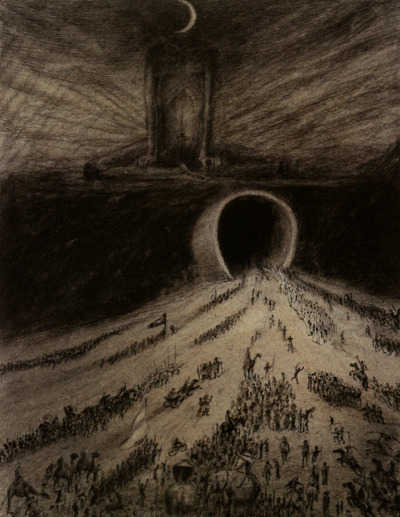 Alfred Kubin: Illustration for Die andere Seite (1908)
Alfred Kubin: Illustration for Die andere Seite (1908)I picked up a hardback copy of this fascinating novel in a Hospice Shop the other day:
 Alfred Kubin: The Other Side (1969)
Alfred Kubin: The Other Side (1969)To be perfectly honest, I didn't really need it, as I've owned a copy of the Penguin Modern Classics edition for a number of years:
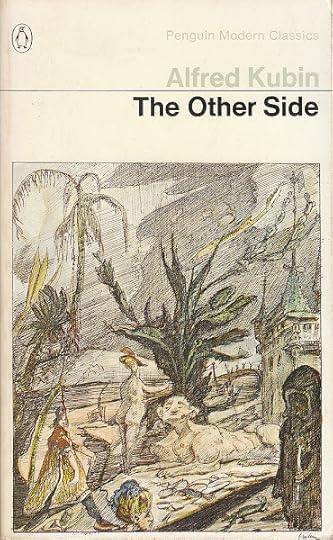 Alfred Kubin: The Other Side (1973)
Alfred Kubin: The Other Side (1973)The book holds a strange appeal for me, I'm not quite sure why.
I first noticed it on my eldest brother's shelves, when he was still living at home before leaving for university. A bit later I found a copy of my own to read (he was a stickler for not allowing anyone else to crease the spines or covers of his books by opening them more than a crack).
One day I mentioned to him that I'd been reading it. "I don't know what you're talking about," he replied. So that was that.
I presumed from his response that he must have forgotten all about the book shortly after buying it, and had no idea that it was still in his collection. Or perhaps he was just in a bad mood that day, and couldn't be bothered discussing it.
It did seem a curious omen, though.
 Alfred Kubin: The Other Side (1967)
Alfred Kubin: The Other Side (1967)Die andere Seite was Kubin's only novel. He wrote it in 1908, after finishing a long series of drawings. Feeling exhausted and unable to create anything new in that medium:
Instead, in order to do something, no matter what, to unburden myself, I now began to compose and write down an adventure story. The ideas came flooding into my mind in superabundance; they forced me to work day and night so that in twelve weeks' time my fantastic novel 'Die andere Seite' [The Other Side] was finished. During the next four weeks I provided it with illustrations. Afterwards, to be sure, I was exhausted and irritable, and I entertained seriousmisgivings about my daring enterprise. I possessed no reliable judgment in literary matters ...
•
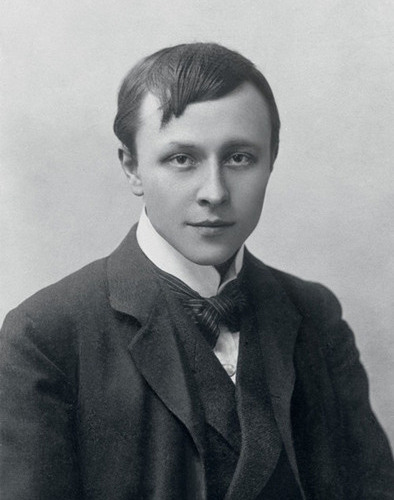 Nicola Perscheid: Alfred Leopold Isidor Kubin (1877–1959)
Nicola Perscheid: Alfred Leopold Isidor Kubin (1877–1959)It's been compared to Kafka's Castle, to Hermann Hesse's Journey to the East, to Mervyn Peake's Gormenghast. It isn't really very like any of them, though.
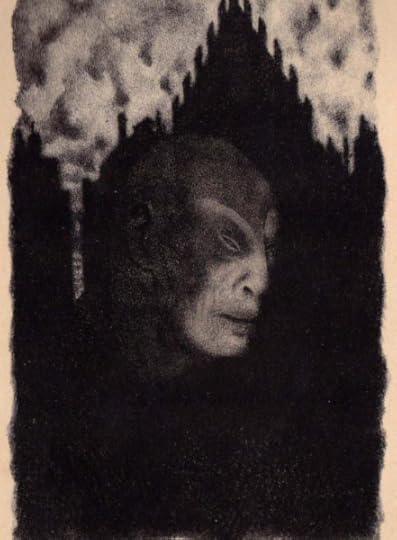 Gustav Meyrink: Der Golem: Frontispiece (1915)
Gustav Meyrink: Der Golem: Frontispiece (1915)What it does resemble more than a little is Gustav Meyrink's The Golem.
 Gustav Meyrink: Der Golem (1915)
Gustav Meyrink: Der Golem (1915)That isn't entirely surprising:
The illustrations for the book were originally intended for The Golem by Gustav Meyrink, but as that book was delayed, Kubin instead worked his illustrations into his own novel. - Wikipedia: Alfred KubinIt's hard to know how literally to take this statement - quoted from Siegfried Schödel's Studien zu den phantastischen Erzählungen Gustav Meyrinks (Nuremberg: Universität Erlangen-Nürnberg, 1965): 27. If The Golem was written "between 1907 and 1914", then "first published in serial form from December 1913 to August 1914 in the periodical Die Weißen Blätter", before being published in book form in 1915, it's a bit difficult to see how Kubin could have been working on illustrations for it as early as 1907-8.
Certainly there's no mention of the fact in the short autobiography appended to the successive editions of Die andere Seite published in Kubin's lifetime (and finally printed in full in the 1967 English translation of The Other Side). What he does say is that it coincided with a period of aimlessness and depression after the death of his very controlling - and emotionally distant - father in November 1907.
The atmosphere of Prague's tangled old streets, omnipresent in Meyrink's somewhat plotless novel, may well have contributed something to Kubin's creation of his Central Asian Dream Kingdom, constructed by the narrator's old schoolfriend Patera with the intention of preserving only broken-down, abandoned relics of the Europe he's left behind. Nor is it difficult to see in the name "Patera" an echo of Kubin's recent paternal loss.
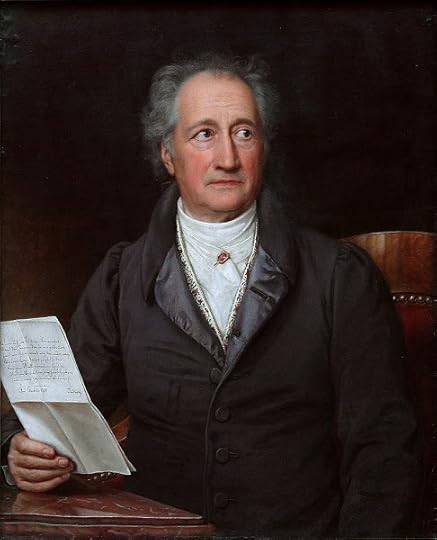 Joseph Karl Stieler: Johann Wolfgang von Goethe (1749-1832)
Joseph Karl Stieler: Johann Wolfgang von Goethe (1749-1832)The life-and-death struggle between the paternalistic ruler Patera - at one point explicitly equated with the mad "Dream King" Ludwig II of Bavaria [223-24] - and his upstart nemesis Hercules Bell, the American tycoon, who turns up in the Dream Kingdom fresh from "poking about in the islands of New Zealand" [172], tempts one to posit an elaborate satire on Goethe's famous vision of America and the New World as offering a fresh, clean slate for mankind to write upon:
Amerika, du hast es besser
Als unser Kontinent, der alte,
Hast keine verfallenen Schlösser
Und keine Basalte.
Dich stört nicht im Innern,
Zu lebendiger Zeit,
Unnützes Erinnern
Und vergeblicher Streit.
Benutzt die Gegenwart mit Glück!
Und wenn nun Eure Kinder dichten,
Bewahre sie ein gut Geschick
Vor Ritter-, Räuber- und Gespenstergeschichten.
- Johann Wolfgang von Goethe, "Den Vereinigten Staaten" (1831)
America you're better off
than our continentthe old one
you've got no fallen castles
no ruins to build on
your inner life
is free
of futile strife
and fruitless memory
live in the momentgood luck to you
and when your kids write poetry
try to keep them well away
from robbers ghosts and chivalry
[trans. JR]
 Nicholas Roerich: Svyatogor (1942)
Nicholas Roerich: Svyatogor (1942)Kubin's Dream Kingdom, by contrast, is made up nothing but old ruins, old grudges, and all the detritus of the Old World. It is, admittedly, set on the opposite side of the globe from the United States, in the ageless steppes of Central Asia, inhabited by a strange blue-eyed race of mystics, who appear to have leased the land he builds on to the absurdly rich - and equally enigmatic - Patera.
It seems unlikely that Kubin was familiar with the work of his near contemporary Nicholas Roerich (1874-1947) at the time he wrote Die andere Seite - Roerich's Symbolist designs did not really become famous in the West until he created the sets for Borodin's Prince Igor (1909) and Stravinsky's The Rite of Spring (1913) for Diaghilev's Ballets Russes.
One can see in him something of the same fascination with this ancient, mystic land of Nomad empires and esoteric religions, however. Certainly H. P. Lovecraft, whose fabled plateau of Leng was avowedly inspired by Roerich's paintings, must have thought so.
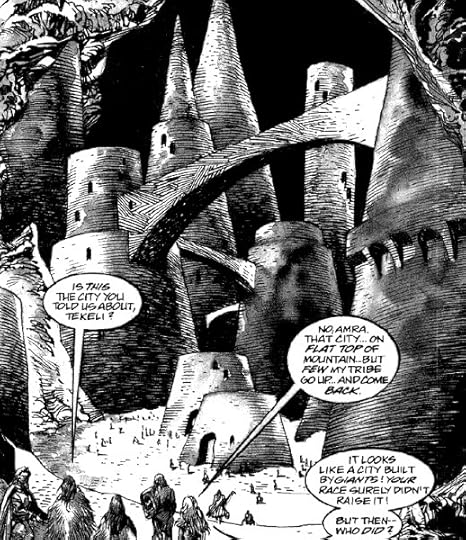 Marvel Comics: Conan the Savage #4 (1995)
Marvel Comics: Conan the Savage #4 (1995)•
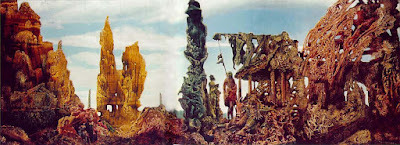 Max Ernst: Europe after the Rain (1940-42)
Max Ernst: Europe after the Rain (1940-42)But all this is taking us quite a way from Kubin's novel, composed in 1908, long before World War I - let alone the even more Apocalyptic World War II - had convulsed his native Austria in blood and flame.
He describes his rather dismal experiences of privation and want in both wars in the Autobiography at the end of his novel, but nowhere makes the explicit connection between the cataclysmic fall of Patera's Dream Kingdom with those of the Hapsburg Empire and Hitler's thousand-year Reich.
Might we then read Die andere Seite as a premonitory vision?
... not nonsense, but the confused fragments of a dream: a dream that no sane man could bear to dream: a waking memory of what was to be.- Alan Garner, Elidor (1965): 48.Certainly many of the descriptions Kubin gives of himself would scarcely qualify as sane - perhaps "highly strung" would be the most diplomatic formula for some of the behaviour he confesses to at this particular time.
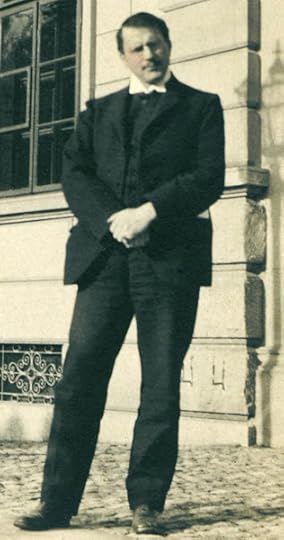 Max Ernst: Carl Gustav Jung (1875-1961)
Max Ernst: Carl Gustav Jung (1875-1961)In any case, he wouldn't be the only one to report having had strange dreams and visions before the advent of the "War to end all Wars":
In October [1913], while I was alone on a journey, I was suddenly seized by an overpowering vision: I saw a monstrous flood covering all the northern and low-lying lands between the North Sea and the Alps. When it came up to Switzerland I saw that the mountains grew higher and higher to protect our country. I realized that a frightful catastrophe was in progress. I saw the mighty yellow waves, the floating rubble of civilization, and the drowned bodies of uncounted thousands. Then the whole sea turned to blood. This vision last about one hour. I was perplexed and nauseated, and ashamed of my weakness.
Two weeks passed; then the vision recurred, under the same conditions, even more vividly than before, and the blood was more emphasized. An inner voice spoke. "Look at it well; it is wholly real and it will be so. You cannot doubt it." That winter someone asked me what I thought were the political prospects of the world in the near future. I replied that I had no thoughts on the matter, but that I saw rivers of blood.
I asked myself whether these visions pointed to a revolution, but could not really imagine anything of the sort. And so I drew the conclusion that they had to do with me myself, and decided that I was menaced by a psychosis. The idea of war did not occur to me at all.
Soon afterward, in the spring and early summer of 1914, I had a thrice-repeated dream that in the middle of summer an Arctic cold wave descended and froze the land to ice. I saw, for example, the whole of Lorraine and its canals frozen and the entire region totally deserted by human beings. All living green things were killed by frost. This dream came in April and May, and for the last time in June, 1914.
In the third dream frightful cold had again descended from out of the cosmos. This dream, however, had an unexpected end. There stood a leaf-bearing tree, but without fruit (my tree of life, I thought), whose leaves had been transformed by the effects of the frost into sweet grapes full of healing juices. I plucked the grapes and gave them to a large, waiting crowd ...
On August 1 the world war broke out.
- Carl Gustav Jung, Memories, Dreams, Reflections. Ed. Aniela Jaffé. Trans. Richard & Clara Winston. 1965. Revised edition (New York: Vintage, 1973): 175-76.
•
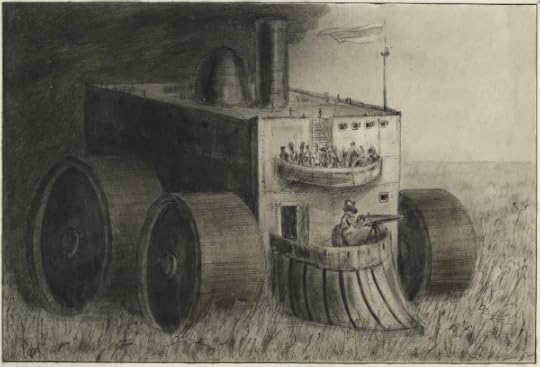 Alfred Kubin: Der Staat (1901)
Alfred Kubin: Der Staat (1901)•
Published on May 14, 2024 16:13
May 3, 2024
Idle Days
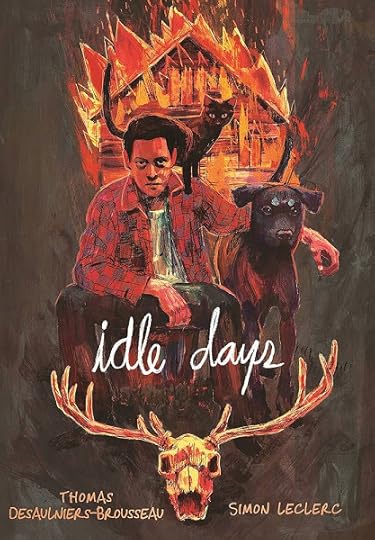 Thomas Desaulniers-Brousseau: Idle Days (2018)
Thomas Desaulniers-Brousseau: Idle Days (2018)Thomas Desaulniers-Brousseau. Idle Days. Art by Simon Leclerc. First Second. New York: Roaring Brook Press, 2018.
A long time ago now - has it really been fifteen years? - I wrote a post called "Unpacking my Comics Library". I see that, to date, it's received 11,671 views, and attracted 15 comments. That's pretty good going - for my blog, at any rate.
I don't propose to write another survey post like that one, but a number of graphic novels have found their way into my collection since then. One of the strangest I've run into would have to be Thomas Desaulniers-Brousseau's Idle Days, a family saga set in the Canadian woods, where a deserter is living with his grandfather during the last days of the Second World War.
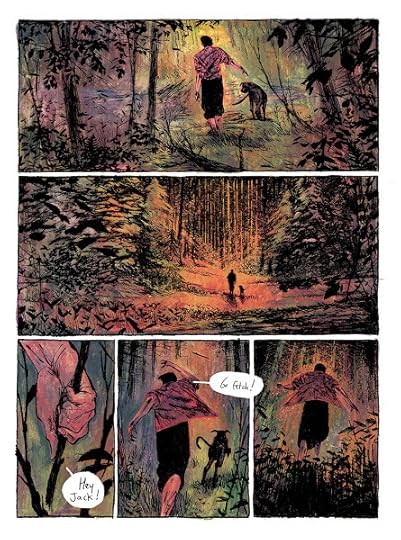 Simon Leclerc: Art for Idle Days (2018)
Simon Leclerc: Art for Idle Days (2018)Simon Leclerc's art for the comic is almost equally obsessive and internalised. As he himself puts it in a joint interview with Paste Magazine (February 2, 2016):
Jerome, being a deserter, finds himself forced to live in his grandfather’s house, isolated in the woods nearby. The story then unfolds around that house; the forced reclusiveness gets Jerome interested in the previous generations of the house owners and their mysterious and tragic fates that weirdly relate to his. Along the way, the forest unveils its haunting characters: a dead woman, alcohol smugglers, a witch, a black cat, all while Jerome has to deal with his grumpy grandfather!The interview as a whole confirms the strongly personal nature of the story's background. Author Desaulniers-Brousseau explains:
My father’s father, whom I never knew, deserted just before his regiment was deployed in Vancouver, worried that he would eventually be sent to fight in Europe. He apparently regretted it because the regiment never left British Columbia, and his friends otherwise “enjoyed a nice trip.” I hope I’m not being insensitive towards our veterans right now, that’s not my intention. But anyway, he hid with his uncle, a doctor in the village, and his experience has inspired the character of Jerome and some of the events of the story. Maybe it was a desire to know more about his life that led me to write this story. But Jerome is also me in a lot of ways, and the relationship that develops between him and his grandfather is a sort of imaginary dialogue with pretty much all the male authority figures in my life, of which Maurice is the melting pot.
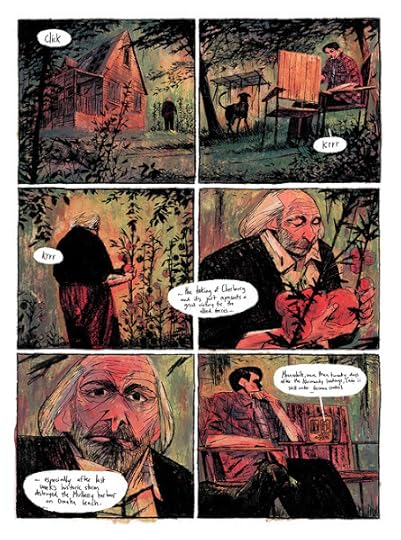 Simon Leclerc: Art for Idle Days (2018)
Simon Leclerc: Art for Idle Days (2018)Leclerc seems more focussed on the technical challenges of the comics medium:
A book like Idle Days (and graphic novels in general) is great because it gives me the opportunity to art-direct my project entirely.In the end, whereas Desaulniers-Brousseau admits that 'it certainly has a meaning and a message for me.'
Personal projects demand that you raise your level of creativity, that you level up your inventiveness, because the thing you are making is your own. In my opinion, comics is one of the last mediums where the editors as well as the audience expect the authors to push and play with its boundaries as much as they do.
I choose the level of stylization I want to inject, the amount of time I decide to put drawing these tiny leaves on that weirdly shaped tree, or whether I want to leave that scribbly line that doesn’t really make sense on the nose of my character, but that I find oddly beautiful and satisfying.
it’s basically a ghost story. I hope people have an enjoyable time reading it, and if they can find echoes in their own lives, well that’s just tops.Leclerc, by contrast, just wants people to 'look at it and go: “Cool! That drawing of a tree looks gnarly!”'
I guess I have a soft spot for this oddly formless, intensely atmospheric graphic novel for a number of reasons. I found it lurking in a pile of other comics in a Hospice shop, and it always gives me a warm feeling to rescue interesting books which have been abandoned there.
More than that, though, it was probably the title that attracted me most. I do have a taste for intense, autobiographical Canadian comics - I used to read all I could find in the days when they were constantly on display on the ground floor racks in the Auckland Central Library.
But Idle Days ... what an evocative concept!
•
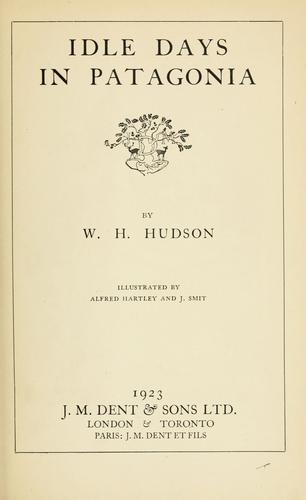 W. H. Hudson: Idle Days in Patagonia (1893)
W. H. Hudson: Idle Days in Patagonia (1893)Far away and long ago I lived in an east-windy, West-Endy city called Edinburgh, which prided itself on being the 'Athens of the North' (though Tom Stoppard referred to it 'the Reykjavik of the South'). One of the things I did there was collect and read the works of W. H. Hudson, an Anglo-Argentinian naturalist, who specialised in dreamy books about birds and the romance of the plains and jungles of South America.
Idle Days in Patagonia is one of his most celebrated works, perhaps the first in which he achieves fusion between the scientific classification of bird species and the belletristic fine writing about nature for which he became famous. Years later it would inspire Bruce Chatwin to make his own visit to Argentina, the subject of his first travel book, In Patagonia.
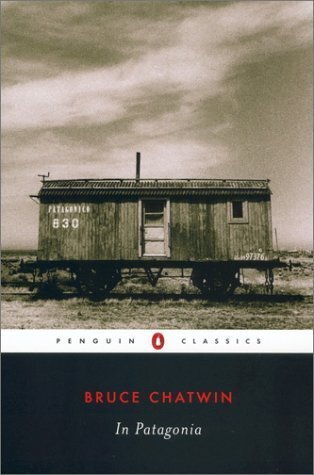 Bruce Chatwin: In Patagonia (1977)
Bruce Chatwin: In Patagonia (1977)Bruce Chatwin was a born liar. When his book became famous, many of the people he'd interviewed (or claimed to interview) came forward to denounce him for putting words in their mouths. This is a not uncommon dilemma for travel writers, who inhabit a curious no-man's-land between truth and fiction, and who therefore tend to regard themselves as entitled to distort chronologies, ginger up otherwise flat narratives into something more exciting, and generally confuse things in the hopes of confounding any subsequent attempts to check up on them.
Chatwin did take this trait further than most, however, and it's therefore best to regard all of his books as either directly or indirectly fictional, whether or not he (or his publishers) described them as "novels" or "travel books". Perhaps it's true that the devil finds work for idle hands ...
•
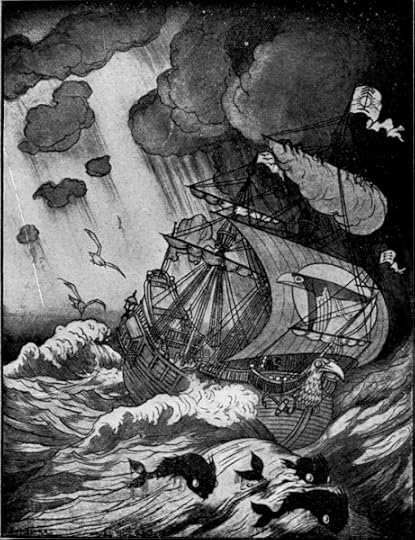 Sidney Sime: Bird of the River
Sidney Sime: Bird of the RiverIdle Days on the Yann
There doesn't seem much doubt that Lord Dunsany's long fantasy story "Idle Days on the Yann" (from A Dreamer's Tales, 1910) was inspired by W. H. Hudson's Idle Days in Patagonia - or at any rate by its title.
So I came down through the wood to the bank of Yann and found, as had been prophesied, the ship Bird of the River about to loose her cable.
The captain sate cross-legged upon the white deck with his scimitar lying beside him in its jewelled scabbard, and the sailors toiled to spread the nimble sails to bring the ship into the central stream of Yann, and all the while sang ancient soothing songs. And the wind of the evening descending cool from the snowfields of some mountainous abode of distant gods came suddenly, like glad tidings to an anxious city, into the wing-like sails.This story had a deep influence on H. P. Lovecraft, particularly on his early novel The Dream-Quest of Unknown Kadath (1926-27). According to Wikipedia , Dunsany's story was written "in anticipation for a trip down the Nile."
And so we came into the central stream, whereat the sailors lowered the greater sails. But I had gone to bow before the captain, and to inquire concerning the miracles, and appearances among men, of the most holy gods of whatever land he had come from. And the captain answered that he came from fair Belzoond, and worshipped gods that were the least and humblest, who seldom sent the famine or the thunder, and were easily appeased with little battles. And I told how I came from Ireland, which is of Europe, whereat the captain and all the sailors laughed, for they said, 'There are no such places in all the land of dreams.' When they had ceased to mock me, I explained that my fancy mostly dwelt in the desert of Cuppar-Nombo, about a beautiful blue city called Golthoth the Damned, which was sentinelled all round by wolves and their shadows, and had been utterly desolate for years and years because of a curse which the gods once spoke in anger and could never since recall. And sometimes my dreams took me as far as Pungar Vees, the red-walled city where the fountains are, which trades with the Isles and Thul. When I said this they complimented me upon the abode of my fancy, saying that, though they had never seen these cities, such places might well be imagined. For the rest of that evening I bargained with the captain over the sum that I should pay him for my fare if God and the tide of Yann should bring us safely as far as the cliffs by the sea, which are named Bar-Wul-Yann, the Gate of Yann.The story itself bears a certain resemblance to C. P. Cavafy's most famous poem, "Ithaka" (1911), which gives a similarly meandering account of a journey whose true purpose is not its destination so much as the incidents along the way.
And now the sun had set, and all the colours of the world and heaven had held a festival with him, and slipped one by one away before the imminent approach of night. The parrots had all flown home to the jungle on either bank, the monkeys in rows in safety on high branches of the trees were silent and asleep, the fireflies in the deeps of the forest were going up and down, and the great stars came gleaming out to look on the face of Yann. Then the sailors lighted lanterns and hung them round the ship, and the light flashed out on a sudden and dazzled Yann, and the ducks that fed along his marshy banks all suddenly arose, and made wide circles in the upper air, and saw the distant reaches of the Yann and the white mist that softly cloaked the jungle, before they returned again into their marshes.I wrote a version of Cavafy's poem once - not a direct translation, since I speak no Greek, but a beefed-up version of a literal, word-for-word version I located somewhere. You can find it here.
And then the sailors knelt on the decks and prayed, not all together, but five or six at a time. Side by side there kneeled down together five or six, for there only prayed at the same time men of different faiths, so that no god should hear two men praying to him at once. As soon as any one had finished his prayer, another of the same faith took his place. Thus knelt the row of five or six with bended heads under the fluttering sail, while the central stream of the River Yann took them on towards the sea, and their prayers rose up from among the lanterns and went towards the stars. And behind them in the after end of the ship the helmsman prayed aloud the helmsman's prayer, which is prayed by all who follow his trade upon the River Yann, of whatever faith they be. And the captain prayed to his little lesser gods, to the gods that bless Belzoond.There is something irresistibly attractive in the idea of long river cruises, drifting past temples and villages, with fishermen plying their trade, and pilgrims coming down to the shore to wash away their sins. I've only experienced it once or twice, and then only for a brief time, but it's an agreeable thing to think about.
And I too felt that I would pray. Yet I liked not to pray to a jealous God there where the frail affectionate gods whom the heathen love were being humbly invoked; so I bethought me, instead, of Sheol Nugganoth, whom the men of the jungle have long since deserted, who is now unworshipped and alone; and to him I prayed.Dunsany was once a writer who was spoken of in the same breath as Yeats: a playwright, a poet, a fantasist whose works are now only read for their "influence" on such colossi as Lovecraft or Robert E. Howard. And perhaps that's appropriate. But there's no denying the charm of such stories as "Idle Days on the Yann."
And upon us praying the night came suddenly down, as it comes upon all men who pray at evening and upon all men who do not; yet our prayers comforted our own souls when we thought of the Great Night to come.The story is not entirely episodic, mind you - like so many of Dunsany's works, it hinges on a central terrifying fact which his dreamer protagonist is unwilling to accept, lest it destroy the whole fabric of the world as he knows it. In this case the unassimilable truth is a cyclopean city gate carved out of a single tusk. And his fear is that the owner of the tusk may still be looking for it, up in the hills that look down on the town of Perdóndaris.
And so Yann bore us magnificently onwards, for he was elate with molten snow that the Poltiades had brought him from the Hills of Hap, and the Marn and Migris were swollen full with floods; and he bore us in his might past Kyph and Pir, and we saw the lights of Goolunza.Perhaps the clearest analogue to all this is Italo Calvino's classic novel Invisible Cities, where the peripatetic Marco Polo describes the cities of his empire to the invincibly static Kublai Khan, who will never otherwise be able to experience them at all.
Soon we all slept except the helmsman, who kept the ship in the mid-stream of Yann.The truth of Marco Polo's account has (of course) been under question since it was first written - and the same has to be said of Calvino's fictional Marco's tales told to his master. Do any of these cities actually exist? They sound allegorical rather than real, but then the same might be said of any traveller's tale.
... And the time was come when the captain and I must part, he to go back again to his fair Belzoond in sight of the distant peaks of the Hian Min, and I to find my way by strange means back to those hazy fields that all poets know, wherein stand small mysterious cottages through whose windows, looking westwards, you may see the fields of men, and looking eastwards see glittering elfin mountains, tipped with snow, going range on range into the region of Myth, and beyond it into the kingdom of Fantasy, which pertain to the Lands of Dream.I used to teach a course on Travel Writing, where we explored such questions. In particular, we spent a good deal of time discussing the distinction between Marco Polo's true experiences of the East, and their transmission through the medium of a manuscript written by Rustichello of Pisa, who shared a cell with him in Genoa, and beguiled his leisure by taking notes on his garrulous fellow-prisoner's travel stories. Rustichello had previously made his living as a composer of chivalrous romances.
Long we regarded one another, knowing that we should meet no more, for my fancy is weakening as the years slip by, and I go ever more seldom into the Lands of Dream. Then we clasped hands, uncouthly on his part, for it is not the method of greeting in his country, and he commended my soul to the care of his own gods, to his little lesser gods, the humble ones, to the gods that bless Belzoond.
 Italo Calvino: Invisible Cities (1972)
Italo Calvino: Invisible Cities (1972)•
 Saul Bellow: Dangling Man (1944)
Saul Bellow: Dangling Man (1944)It isn't actually called "Idle Days", but Saul Bellow's debut novel certainly unpacks the concept with mordant precision. Published in 1944, the same year that Desaulniers-Brousseau's graphic novel is set in, Dangling Man is the diary of a young draftee, waiting to be called up for the army, and thus unable to settle to any other task.
It's the perfect situation for a prototypical existentialist novel of self-doubt. And, like Camus's Meursault, Bellow's Joseph duly proceeds to get up to didoes, interfering in his neighbours' lives, and generally making a bit of a mess of his last days of freedom. The war intervenes to save him from himself, though, just as execution for murder does for Camus's unfortunate protagonist.
Dangling Man bears little resemblance to the later, more sprawling American sagas we associate with Saul Bellow, and seems, still, to have a quite separate audience.
I suppose that the general message that an idle man is a menace in the making rings through all of these diverse narratives. Bellow's book has been compared to the superfluous man tradition in Russian literature: anti-heroes such as Pushkin's Eugene Onegin, Lermontov's Pechorin, and Turgenev's Tchulkaturin fritter away their inane lives with pointless love affairs and other self-destructive acts.
Perhaps the most famous of them all is Goncharov's Oblomov , whose slothful and indecisive nature makes him incapable even of getting out of bed in the morning.
•
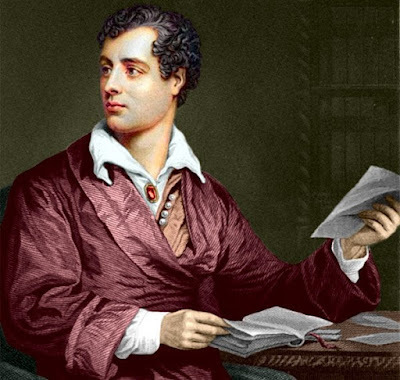 George Gordon, Lord Byron (1788-1824)
George Gordon, Lord Byron (1788-1824)The model for all these angsty idlers is not hard to find. Byron's first book of poems, Hours of Idleness , set the tone for his future work, though it made little impression at the time it first appeared.
The Byronic hero, glamorous, heroic, misanthropic, and (dare I say it?) intensely romantic was, however, to dominate European literature for decades after the appearance of Byron's breakthrough work Childe Harold's Pilgrimage . Doing a lot while seeming to do nothing seems to be the essence of the character. In this he resembles Hamlet, but there was something new there, too.
What T. S. Eliot once described in Burnt Norton as being:
Distracted from distraction by distractionis implied by these exemplars - Byron, Marco Polo, W. H. Hudson, Lord Dunsany - to be the ideal state for poets and creative artists generally.
If Art is what takes place when you're looking elsewhere, then perhaps - like thought - it can only happen if you've allowed yourself (or been permitted by fate) to explore the perilous pleasures of idleness:
Teach us to care and not to care
Teach us to sit still.- Ash-Wednesday
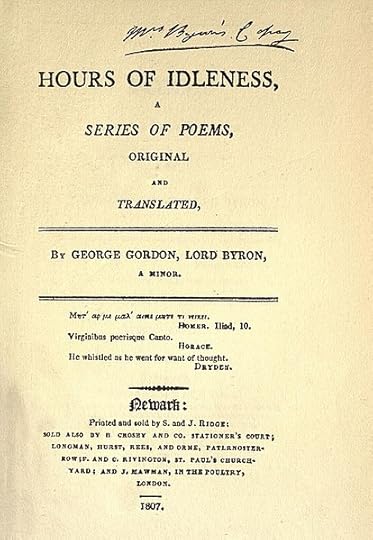 Lord Byron: Hours of Idleness (1807)
Lord Byron: Hours of Idleness (1807)•
Published on May 03, 2024 14:04
April 24, 2024
Judge Dee
 Judge Dee's Mystery (2024)
Judge Dee's Mystery (2024)It's hard to imagine any TV show being much more enjoyable than the latest Chinese adaptation of Robert van Gulik's "Judge Dee" mysteries. I strayed on it accidentally on Netflix, but was initially put off by my memories of reading a couple of rather dull detective novels starring the (semi-) historical sleuth some years ago.
 Yiwei Zhou as Di Renjie (2024)
Yiwei Zhou as Di Renjie (2024)Judge Dee's Mystery certainly starts off with a bang. The new incarnation of Di is apparently a master of Kung Fu as well as possessing a photographic memory: no details ever escape his notice, and - despite his reputation as a ne'er-do-well - his travels in the wastelands around China have clearly taught him a good deal about the world and its ways.
 Di and his love-interests
Di and his love-interestsThe effortlessly cool cast is led by forty-year-old Yiwei Zhou, with Wang Likun as his love-interest Cao An, and Zhong Cuxi as the all-powerful (yet beleaguered) Empress.
 Di's side-kicks
Di's side-kicksBut of course every detective needs his Watson. In this case, as an official magistrate, Di travels with quite an entourage. There's his father's old friend Hong Liang (played by You Yongzhi), Ta Ji as his muscle, Qiao Tai, and Lingzi Qu as the irrepressible Ma Rong.
 Ma Rong
Ma RongThis latter is by far my favourite character. She plays a kind of Sancho Panza to Judge Dee's Don Quixote, and is always ready to scull a drink or start a sword-fight. She's also (clearly) deeply in love with Di Renjie, but is forced to accept the fact that he sees her as a comrade rather than one of the delicate, lute-playing ladies he prefers to keep company with.
 The delectable Cao An
The delectable Cao AnThe plots are (for the most part) absurdly convoluted, and often contain hints of the supernatural. They tend to start in the middle of the hour, presumably to encourage us to continue watching, and last for three or four episodes each. They often begin when Di Renjie is posted to a new district, and is thus forced to try and make sense of the particular intrigues and corruption in his new home base.
 Cao An & Di Renjie share a moment
Cao An & Di Renjie share a moment•
 Sharon Lathan: Robert van Gulik & Family
Sharon Lathan: Robert van Gulik & FamilyRobert Van Gulik, the originator of the series, was born in Holland but brought up in Indonesia, where he first acquired his taste for Eastern cultures and languages. He met his wife Shui Shifang, daughter of a Qing dynasty Imperial, in China during the Second World War. In 1940 he first "stumbled across an obscure and anonymous 18th-century Chinese novel," as Sharon Lathan puts it in her brief online biography of the author:
The novel, titled Wu-tsé-t’ien-szû-ta-ch’i-an (Four great strange cases of Empress Wu’s reign), was a fictional account of the deeds of Judge Dee, one of the heroes of traditional Chinese detective fiction, and was set during the 7th-century Tang Dynasty. ... Robert not only translated the novel into English, he delved into the history of Chinese Penal Code and other legal literature of the period. Between WWII and his diplomatic duties, it was not until 1949 that Robert was able to publish his translation — Dee Goong An: Three Murder Cases Solved by Judge Dee ..."Not until 1956 did he translate and publish his first three novels into English and Dutch. All of his subsequent novels were published in English first, with the translations coming afterwards."His fascination with old Chinese detective stories, and with Judge Dee, prompted Robert van Gulik to write original stories for modern readers. His first original story was The Chinese Maze Murders published in 1951, but only in Japanese and Chinese as he believed the stories would have more interest to readers from those cultures. He was correct ... so he soon followed with two more novels about Judge Dee.
My English text was meant only as a basis for a printed Chinese and/or Japanese version, my aim being to show modern Chinese and Japanese writers that their own ancient crime-literature has plenty of source material for detective and mystery stories. - Robert van Gulik
 Di Renjie examines a corpse
Di Renjie examines a corpseIf you compare the picture above with the one below, you may get some idea of the superior attractions of the detailed period recreation of Dee's world in the TV series to the original crude drawings van Gulik insisted on inflicting on his text.
To put it bluntly, he was no artist. He was, however, a craftsman in the classical tradition of the Western detective novel. And this mixture between chinoiserie and golden age detection has proved a potent and (saleable) mixture ever since.
 Robert Van Gulik: Dee Goong An (1949)
Robert Van Gulik: Dee Goong An (1949)•
 Di Renjie investigates
Di Renjie investigatesNor would it be impertinent to add that the seventh century CE, the highwater mark of the Tang dynasty in China, is a conveniently distant period to set stories in. The costumes and architecture of the era, lovingly recreated in the TV series, represent the golden age of Chinese civilisation, and are thus familiar to history buffs everywhere. As Ezra Pound once put it, with his customary concision:
a snotty barbarian ignorant of T'ang history need not deceive one - Pisan Cantos, LXXIV: 32.
 Empress Wu
Empress WuI guess that what interests me most about this act of cultural cross-pollination is the complete ease with which it's been carried out. The credits of the TV show are quick to assure us that the stories that follows are fictional, and thus not historically accurate, but the producers seem to anticipate that the fact they were created by "the Dutch author Robert van Gulik" will be of far less significance to their target audience.
 Qiao Tai
Qiao TaiVan Gulik was, admittedly, no mere China buff. He had a PhD in Chinese language and culture from Utrecht University in the Netherlands, and his publications include a number of Academic works on Ancient Chinese art, music and sexuality: all subjects which recur in his fiction. The Judge Dee stories themselves can be dated fairly precisely between 663 and 681 CE, the apogee of the Tang dynasty, before the interregnum of 690-705. His wife's intimate insider's knowledge of Chinese culture and mores must also have been invaluable to him.
 Hong Liang
Hong LiangOne of the online critics of the TV series complains that:
Despite the short stints of multiple cases, the second half of the drama became rather muddied and less intriguing compared to the first half. Ultimately, this drama didn’t live up to its potential given the high production value and strong cast.Given that she also casts aspersions on my favourite character, however, I find it hard to take this critique very seriously:
Ma Rong was bringing about problems left and right to the main cast ... She may be used as a vehicle for Judge Dee to impart certain lessons but the character and the actress were more irritating than entertaining.However, as one of the more succinct comments on her post so eloquently puts it: "Don’t matter to me just give me more."
The series may not be flawless in all aspects, but the Ma Rong / Judge Dee / Cao An triptych seems to me a clear enactment of the classic id / ego / superego paradigm familiar from so much popular fiction: Think Bones / Kirk / Spock in the original Star Trek, or Deanna / Picard / Data in Star Trek: the Next Generation.
You need an emotionally driven character to represent the primacy of bodily appetites: Pigsy in Monkey (for instance) - or Ma Rong. Then you need a more lofty character who embodies wisdom and logical thinking: Tripitaka in Monkey - or, here, the ethereal Cao An.
Finally, you need a fusion of the two - an Everyman character steered from impulse to impulse by these conflicting influences upon them: Monkey himself - or Captain Kirk - or (as in this case) Di Renjie. They represent the ethical person, controlled neither by heart nor head but by both at once ... Where would adventure stories be without them?
 Di Renjie
Di Renjie•
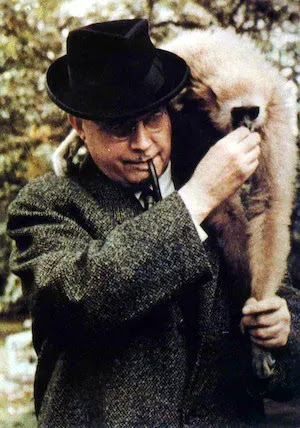 Sharon Lathan: Robert van Gulik with pet gibbon
Sharon Lathan: Robert van Gulik with pet gibbonRobert Hans van Gulik
(1910-1967)
Celebrated Cases of Judge Dee. Translated from Dee Goong An (1949) The Case of the Double Murder at Dawn The Case of the Strange Corpse The Case of the Poisoned Bride Celebrated Cases of Judge Dee (Dee Goong An): An Authentic Eighteenth-Century Detective Novel. Trans. Robert van Gulik. 1949. New York: Dover, 1976. The Chinese Maze Murders (1950 / 1957)Included in: The Haunted Monastery & The Chinese Maze Murders: Two Chinese Detective Novels. 1961 & 1957. New York: Dover, 1977.The Chinese Bell Murders (1958)The Chinese Gold Murders (1959)The Chinese Lake Murders (1960)The Chinese Nail Murders (1961)The Haunted Monastery (1961)Included in: The Haunted Monastery & The Chinese Maze Murders: Two Chinese Detective Novels. 1961 & 1957. New York: Dover, 1977.The Red Pavilion (1961)The Lacquer Screen (1962)The Emperor's Pearl (1963)The Monkey and the Tiger (1965)Morning of the MonkeyThe Night of the Tiger The Willow Pattern (1965)Murder in Canton (1966)The Phantom of the Temple (1966)Judge Dee at Work (1967)Five Auspicious CloudsThe Red Tape MurdersHe Came With the RainThe Murder on the Lotus PondThe Two BeggarsThe Wrong SwordThe Coffins of the EmperorMurder on New Year's Eve Necklace and Calabash (1967)Poets and Murder (1968)
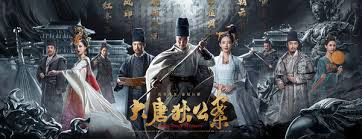 Judge Dee's Mystery (2024)
Judge Dee's Mystery (2024)
Published on April 24, 2024 19:54
April 8, 2024
Finds: A Japanese Doll
 Yaegaki-hime doll (purchased 7/4/24)
Yaegaki-hime doll (purchased 7/4/24)photograph by Bronwyn Lloyd
This doll, which I found a few days ago in a Vintage shop, is clearly a rather distressed version of the one in the auctioneer's picture below. As you can see, while her showcase is intact, it appears to have suffered a little water-damage at some point. I guess what attracted me to her most was the curious white-fur-lined horned helmet she was carrying, though.
 Yaegaki-hime doll in showcase (late 20th century)
Yaegaki-hime doll in showcase (late 20th century)Nor did I realise that the pale cardboard backdrop (in my one - not the one above) was supposed to represent falling snow.
 Utagawa Kuniyoshi: Yaegaki-hime (1852)
Utagawa Kuniyoshi: Yaegaki-hime (1852)This nineteenth-century print gives a better idea of the story, I think. As the description puts it:
In one of the most beautiful prints in the series, an elegantly dressed young lady dances with ghostly fox spirits while holding a samurai helmet above her head. She is Yaegaki-hime, heroine of the popular kabuki play Japan's Twenty-four Paragons of Filial Piety ... The play was originally written for the puppet theater and was first performed in Osaka in 1766; it debuted as a kabuki play in Edo in 1776. The story, which takes place on the shores of Lake Suwa ... is a fictionalized version of the real-life rivalry between the Takeda and Uesugi clans during the sixteenth century.
 Brussels Yaegaki-kai: Yaegaki-hime (2011)
Brussels Yaegaki-kai: Yaegaki-hime (2011)But who exactly is she, and what is she doing with that helmet?
Yaegaki is torn by conflicting loyalties to her father, Nagao Kenshin, and her beloved fiancé, Takeda Katsuyori, who has come in secret to the Nagao mansion to recover an heirloom helmet stolen by Yaegaki's father. In the scene known as the 'Fox Fires in the Inner Garden' ... Yaegaki removes the helmet, which is decorated with long white hair, from the shrine in her father's garden where it has been kept. The God of Suwa, who wants the helmet returned to its rightful owners, sends fox spirits as his messengers to help and guide Yaegaki. By following the footsteps of foxes over the ice, she will be able to make a safe crossing over frozen Lake Suwa and deliver the helmet to Katsuyori.
 Brussels Yaegaki-kai: Yaegaki-hime (2011)
Brussels Yaegaki-kai: Yaegaki-hime (2011)In her fascinating online article "Identifying 'Geisha Doll' Types," Dr. Judy Shoaf lists the following set of distinguishing motifs, under the general category of "Dance or theater roles":
 Judy Shoaf: Yaegaki-Hime, a Kabuki role
Judy Shoaf: Yaegaki-Hime, a Kabuki roleWoman with helmet: Yaegaki-HimeSo, while the doll I found yesterday is a very different version of the figure, the presence of a horned Samurai helmet decorated with long white hair is quite sufficient to identify it.A princess (hime) with a silvery crown in her hair. She holds a horned helmet with a tuft of long white hair trailing from it; foxes may also figure in the design in some way. This is the heroine of the play Honcho Nijushiko, set in the 15th [sic.] century. She carries the precious helmet across a frozen lake, with the help of spirit-foxes, to rescue it and also her lover.
 Utagawa Kuniyoshi: Yaegaki-hime (1852)
Utagawa Kuniyoshi: Yaegaki-hime (1852)•
 Burmese String Puppet (purchased 25/5/22)
Burmese String Puppet (purchased 25/5/22)photograph by Bronwyn Lloyd
So now that I know that, what do I do? Why all this detail about a dusty old Japanese doll, found lurking in the corner of an SPCA shop?
I guess mainly because it's fairly typical of the little knick-knacks I've picked up from time to time to decorate my study.
The Japanese doll, Yaegaki-hime, is particularly attractive to me, especially now that I know who she is. She won't stop moving, for one thing: the little dangling metal strips of her headdress keep on vibrating, whether there's any movement outside to provoke it or not. And the whole subject of spirit-foxes, kitsune, in Japanese folklore also greatly appeals to me.
In fact, I can't recall coming across an object that interested me so much since Bronwyn and I found an ornate Burmese puppet - pictured above - in a Northland Hospice Shop, together with a pair of twin male-female marionettes from Rajasthan.
 Burmese puppet
Burmese puppetAs you can see, my one is in much better condition than the one pictured above for sale. Mine still has his sword, for one thing, and the intricacy and detail of his costume has to be seen to be believed. He stares down at me as I work, daring me to do a bit better.
Then there are a number of book-ends and figurines of various types I've collected over the years:
 Egyptian book-ends
Egyptian book-endsGlossy examples of Ancient Egyptian kitsch figure largely, I have to admit, as do such pieces of Chinoiserie as the two temple lions below:
 Chinese Foo Dogs
Chinese Foo DogsThere's nothing really valuable in this collection, I'm sure. But I still like the sense of individuality about the various pieces, crafted initially (no doubt) for the international tourist market, but somehow made special by their peregrinations through the world.
How did they end up in the little vintage shops where I found them? Some are damaged, others pristine, but that just seems to add character.
 Edmund Engelman: Freud's desk (1938)
Edmund Engelman: Freud's desk (1938)A great deal has been written about the choice - and arrangement - of figures on Sigmund Freud's desk in Vienna. I doubt that any such significance can be attributed to my own selection of mainly Eastern puppets and figurines.
But they all feel like friends to me, and I like to examine them and recall the circumstances of our first meetings ...
 Rajasthani Puppets
Rajasthani Puppets
Published on April 08, 2024 13:24
March 2, 2024
Classic Ghost Story Writers: L. P. Hartley
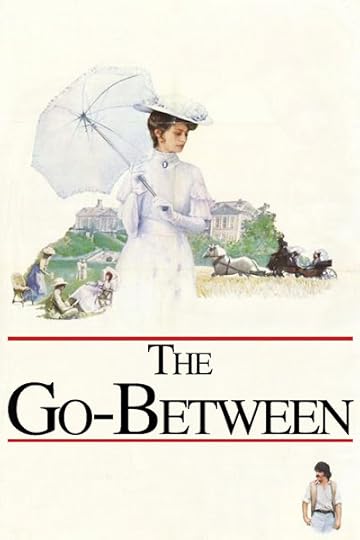 Joseph Losey, dir.: The Go-Between (1971)
Joseph Losey, dir.: The Go-Between (1971)[writ. Harold Pinter / adapted from the 1953 novel by L. P. Hartley]
"The past is a foreign country; they do things differently there.”
This, the first line of The Go-Between, is certainly L. P. Hartley's most commonly quoted phrase - though it was apparently first used by his friend Lord David Cecil in his inaugural lecture as Goldsmiths' Professor in 1949.
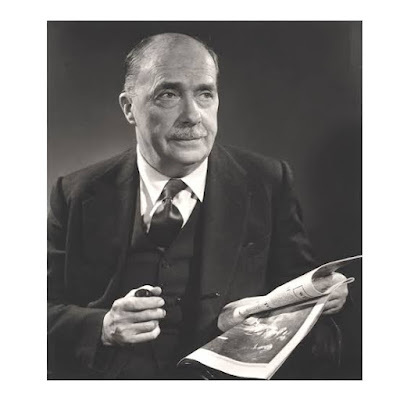 L. P. Hartley (1895-1972)
L. P. Hartley (1895-1972)Among all his other achievements as a writer, Hartley is perhaps not so well known as the author of some of the most effective ghost stories of the twentieth century.
Which are the best among them? Well, "A Visitor from Down Under" certainly takes pride of place. "The Travelling Grave" runs it a close second, though. What else? "Podolo", certainly - possibly "Feet Foremost", also.
You'll note that all of these are quite early stories, written, though not necessarily collected, before the Second World War, after which his energies turned decisively towards establishing himself as a novelist of manners, somewhat in the vein of Aldous Huxley or Henry James.
So what is it that makes this handful of stories so outstanding?
•
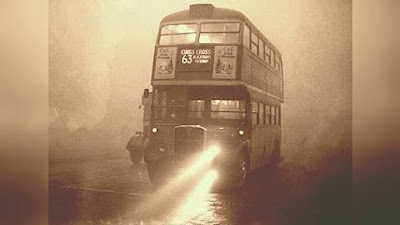 L. P. Hartley: A Visitor from Down Under (1926)
L. P. Hartley: A Visitor from Down Under (1926)Let's start with "A Visitor from Down Under".
The protagonist of the story, Mr. Rumbold, has sat down in the lounge of his hotel to have an apéritif before dinner. After a while, he realises he can hear a voice - "A cultivated voice, perhaps too cultivated, slightly husky, yet careful and precise in its enunciation" - coming from the wall above his head:
‘ . . . A Children’s Party,’ the voice announced in an even, neutral tone, nicely balanced between approval and distaste, between enthusiasm and boredom; ‘six little girls and six little’ (a faint lift in the voice, expressive of tolerant surprise) ‘boys. The Broadcasting Company has invited them to tea, and they are anxious that you should share some of their fun.’ (At the last word the voice became completely colourless.) ‘I must tell you that they have had tea, and enjoyed it, didn’t you, children?’ (A cry of ‘Yes,’ muffled and timid, greeted this leading question.) ‘We should have liked you to hear our table-talk, but there wasn’t much of it, we were so busy eating.’ For a moment the voice identified itself with the children. ‘But we can tell you what we ate. Now, Percy, tell us what you had.’Obviously a voice on the radio, obviously from some kind of children's hour broadcast. So far, so banal. But as it continues, things begin to seem just a little bit ... off:
A piping little voice recited a long list of comestibles; like the children in the treacle-well, thought Rumbold, Percy must have been, or soon would be, very ill. A few others volunteered the items of their repast. ‘So you see,’ said the voice, ‘we have not done so badly. And now we are going to have crackers, and afterwards’ (the voice hesitated and seemed to dissociate itself from the words) ‘Children’s Games.’ There was an impressive pause, broken by the muttered exhortation of a little girl. ‘Don’t cry, Philip, it won’t hurt you.’ Fugitive sparks and snaps of sound followed; more like a fire being kindled, thought Rumbold, than crackers. A murmur of voices pierced the fusillade. ‘What have you got, Alec, what have you got?’ ‘I’ve got a cannon.’ ‘Give it to me.’ ‘No.’ ‘Well, lend it to me.’ ‘What do you want it for?’ ‘I want to shoot Jimmy.’After that the games begin. After "Ring-a-Ring of Roses", it's "Oranges and Lemons", with its sinister refrain:
"Mr. Rumbold felt quite upset, and great was his relief when, after a few more half-hearted rounds of ‘Oranges and Lemons,’ the Voice announced, ‘Here We Come Gathering Nuts and May.’ At least there was nothing sinister in that."Here is a candle to light you to bed,A child screamed, and there was silence.
And here comes a chopper to chop off your head!
Chop—chop—chop.
The game began afresh. This time there was an eager ring in the children’s voices: two tried antagonists were going to meet: it would be a battle of giants. The chant throbbed into a war-cry.I think by now we can tell that it's all up with Mr. Victor Rumbold. Whatever it is that he's been getting up to down under, Jimmy Hagberd's coming to deal with him. And, when the visitor finally arrives at the hotel:Who will you have for your Nuts and May,They would have Victor Rumbold for Nuts and May, Victor Rumbold, Victor Rumbold: and from the vindictiveness in their voices they might have meant to have had his blood, too.
Nuts and May, Nuts and May;
Who will you have for your Nuts and May
On a cold and frosty morning?And who will you send to fetch him away,Like a clarion call, a shout of defiance, came the reply:
Fetch him away, fetch him away;
Who will you send to fetch him away
On a cold and frosty morning?We’ll send Jimmy Hagberd to fetch him away,
Fetch him away, fetch him away;
We’ll send Jimmy Hagberd to fetch him away
On a wet and foggy evening.
‘... take this message to Mr. Rumbold,’ said the stranger. ‘Say, “Would he rather that I went up to him, or that he came down to me?” ’It doesn't make much difference in the end.
There are, to be sure, many such stories of nemesis being visited upon some smug fraudster, but it's the incidental details - such as the fact that the visitor comes to Mr. Rumbold on the top of a London bus, and finds considerable difficulty in paying his fare - which singles it out from the others:
‘Look here, now. Where do you want this ticket? In your button-hole?’That radio broadcast, steadily getting stranger and stranger, is the real prize of the piece, however. The person who wrote that had some personal demons, I would say, or at any rate found little difficulty in conjuring up such things.
‘Put it here,’ said the passenger.
‘Where?’ asked the conductor. ‘You aren’t a blooming letter-rack.’
‘Where the penny was,’ replied the passenger. ‘Between my fingers.’
The conductor felt reluctant, he did not know why, to oblige the passenger in this. The rigidity of the hand disconcerted him: it was stiff, he supposed, or perhaps paralysed. And since he had been standing on the top his own hands were none too warm. The ticket doubled up and grew limp under his repeated efforts to push it in. He bent lower, for he was a good-hearted fellow, and using both hands, one above and one below, he slid the ticket into its bony slot.
•
 Hermione Lee: Penelope Fitzgerald: A Life (2014)
Hermione Lee: Penelope Fitzgerald: A Life (2014)Penelope Fitzgerald, before she took to writing fiction, spent quite a number of years researching a biography of L. P. Hartley. She'd already written a book about her father and three eccentric uncles, The Knox Brothers (1977), as well as a life of the poet Charlotte Mew.
The L. P. Hartley book remained still-born, however, which is a bit of a shame. There are many respects in which she might have been the ideal commentator on the immense oddity of both his inner and outer lives.
It's an open secret that the intense brother-and-sister relationship which is the principal subject of his Eustace and Hilda trilogy is based on his own feelings about his domineering older sister Enid. He was 49 before he dared to publish it, and it made him famous. When he followed it a few years later with The Go-Between, W. H. Auden told Hartley that he was his favourite novelist.
Not everyone was so enthusiastic about his work. After the publication of his first long fiction Simonetta Perkins (1925), Virginia Woolf asked him, "Have you written any more shabby books, Mr. Hartley?" referring to it as "one that might have been written by a man with one foot in England and the other in Venice".
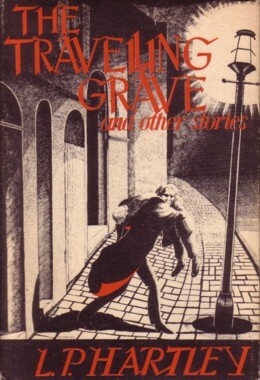
L. P. Hartley: The Travelling Grave and Other Stories (1948)
•
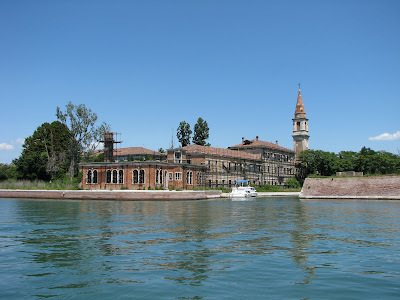 Poveglia (Venice)
Poveglia (Venice)The second story I've chosen to discuss is one which nicely illustrates the problems associated with being "a man with one foot in England and the other in Venice." It's called "Podolo," and is set on a small island in the Venetian lagoon. So far as I can tell, there is no island called "Podolo", but there's certainly one called "Poveglia" (pictured above):
For more than 100 years, beginning in 1776, the island was used as a quarantine station for those suffering the plague and other diseases, and later as a mental hospital. The mental hospital closed in 1968, and the island has been vacant ever since ...What, then, of the story itself? It begins with some lighthearted plans for a visit to the island by the narrator, his friend Angela, and her husband Walter. Walter cries off, as he has business in Trieste, so the other two set off for their picnic together.
Visits to the island are prohibited, but various books and articles report on visits by writers and/or photographers. Believers in the paranormal have claimed that Poveglia is the most haunted island, or the most haunted place in the world.- Wikipedia: Poveglia
The sunlight sparkled on the water; the gondola, in its best array, glowed and glittered. ‘Say good-bye to Angela for me,’ cried Walter as the gondolier braced himself for the first stroke. ‘And what is your postal address at Podolo?’ ‘Full fathom five,’ I called out, but I don’t think my reply reached him.There are already some ominous undertones in this sunny opening. There's clearly something going on between the narrator and Angela, right under Walter's nose, and getting her away to a deserted spot seems more than a trifle devious on his part. As for their destination:
Until you get right up to Podolo you can form no estimate of its size. There is nothing near by to compare it with. On the horizon it looks like a foot-rule. Even now, though I have been there many times, I cannot say whether it is a hundred yards long or two hundred. But I have no wish to go back and make certain.The trouble begins shortly after they reach the island. Angela spots a mangy little stray cat, and is determined to catch it and bring it back with them. After a few unavailing attempts to seize it, after luring to her with food, she changes her approach:
‘I tell you what,’ Angela said suddenly, ‘if I can’t catch it I’ll kill it. It’s only a question of dropping one of these boulders on it. I could do it quite easily.’ She disclosed her plan to Mario [the gondolier], who was horror-struck. His code was different from hers. He did not mind the animal dying of slow starvation; that was in the course of nature. But deliberately to kill it! ‘Poveretto! It has done no one any harm,’ he exclaimed with indignation. But there was another reason, I suspected, for his attitude. Venice is overrun with cats, chiefly because it is considered unlucky to kill them. If they fall into the water and are drowned, so much the better, but woe betide whoever pushes them in.Angela is unimpressed by Mario - and the narrator's - logic.
‘Let’s go and explore the island,’ she said, ‘until it’s time to bathe. The cat will have got over its fright and be hungry again by then, and I’m sure I shall be able to catch it. I promise I won’t murder it except as a last resource.’I don't think I can say too much more without spoiling the story for you, but let's just say that the narrator dozes off after his meal, and Angela goes off exploring by herself. Their search for her, on the tiny, darkening island, is pretty perfunctory. Mainly because there appears to be someone - or something - else there.
We soon lost sight of each other in the darkness, but once or twice I heard Mario swearing as he scratched himself on the thorny acacias. My search was more successful than I expected. Right at the corner of the island, close to the water’s edge, I found one of Angela’s bathing shoes: she must have taken it off in a hurry for the button was torn away. A little later I made a rather grisly discovery. It was the cat, dead, with its head crushed. The pathetic little heap of fur would never suffer the pangs of hunger again. Angela had been as good as her word.At this point, Mario rushes up, bundles him into the boat, and starts rowing frantically away from the island. Later on he explains:
‘When I found her,’ he whispered, ‘she wasn’t quite dead.’Make of that what you will.
I began to speak but he held up his hand.
‘She asked me to kill her.’
‘But, Mario!’
‘ “Before it comes back,” she said. And then she said, “It’s starving, too, and it won’t wait. ...” ’ Mario bent his head nearer but his voice was almost inaudible.
‘Speak up,’ I cried. The next moment I implored him to stop.
Mario clambered on to the poop.
‘You don’t want to go to the island now, signore?’
‘No, no. Straight home.’
I looked back. Transparent darkness covered the lagoon save for one shadow that stained the horizon black. Podolo. ...
It's not that the plot of the story is so remarkable. Just as "A Visitor from Down Under" is a fairly standard vengeful revenant story, so "Podolo" is an account of what you fear might happen if you wander around some haunted old ruins at twilight. But in both cases it's the odd, outré details that count: In "A Visitor" it's the threatening radio broadcast, and in "Podolo" it's the joint, unspoken decision both men, the gondolier and her cavalier servente, make to leave Angela behind on the island.
She (it is implied) is the trouble-maker; she is the one who has insisted on hunting through all the crevices of the island for the small but viciously feral cat, despite Mario's warning that "It has been put here on purpose." And whatever she finds there is far beyond her powers, just as it turns out, unfortunately, to be equally far beyond theirs.
It's a dark, rather nasty story, which leaves a bad taste in the mouth. But it's also an almost perfect illustration of M. R. James's doctrine that less is more:
Let us be introduced to the actors in a placid way; let us see them going about their ordinary business, undisturbed by forebodings, pleased with their surroundings; and into this calm environment let the ominous thing put out its head, unobtrusively at first, and then more insistently, until it holds the stage.
•
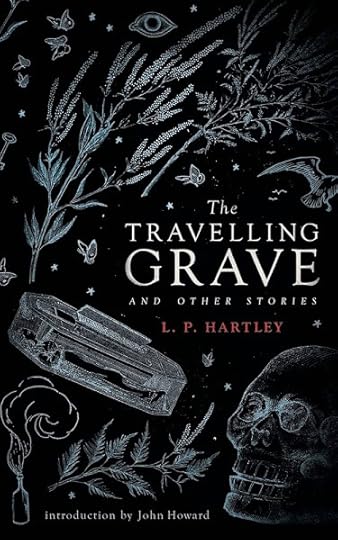 L. P. Hartley: The Travelling Grave (2017)
L. P. Hartley: The Travelling Grave (2017)I'd like to go on and analyse some more of his stories: "The Travelling Grave" itself, in particular, not to mention the haunted house story "Feet Foremost", but I hope that I've said enough to persuade you that L. P. Hartley was a haunted man, and therefore a haunted writer.
Not everyone can combine the two conditions, and his later work does not really maintain the fierce intensity of these early stories. His Complete Stories is a fascinating book, however: well worth reading from cover to cover by anyone who has the time or the inclination.
Though perhaps, as many of his stories imply, you'd better make time. The life you save may be your own. Even if it involves sacrificing a cat-killer - or (for that matter) a coffin-collector, or a few of their business associates - along the way ...
 Adrian Wright: Foreign Country: The Life of L. P. Hartley (1996)
Adrian Wright: Foreign Country: The Life of L. P. Hartley (1996)"Drawing on exclusive access to unpublished private papers, this is the first biography of novelist Leslie Poles Hartley, covering his life and work from his childhood at Fletton Tower, Peterborough, his relationship with his mother, his experiences in the Great War, his homes in Venice, Bath and London, and his struggle to come to terms with his homosexuality."
•
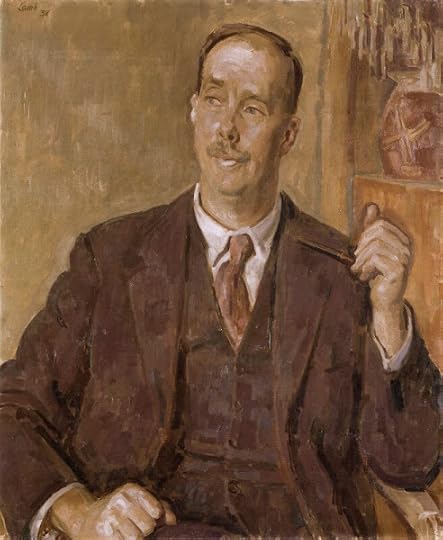
Henry Lamb: L. P. Hartley (1938)
Leslie Poles Hartley
(1895-1972)
Novels:
Simonetta Perkins (1925)Included in: The Complete Short Stories of L. P. Hartley. Introduction by Lord David Cecil. London: Hamish Hamilton, 1973. The Shrimp and the Anemone. Eustace and Hilda Trilogy I (1944) The Sixth Heaven. Eustace and Hilda Trilogy II (1946) Eustace and Hilda. Eustace and Hilda Trilogy III (1947)Included in: Eustace and Hilda: A Trilogy. ['The Shrimp and the Anemone,' 1944; 'The Sixth Heaven,' 1946; 'Eustace and Hilda,' 1947]. 1958. Introduction by Lord David Cecil. London: Faber, 1979. The Boat (1949) My Fellow Devils (1951) The Go-Between (1953) The Go-Between. 1953. The Modern Novel Series. London: Heinemann Educational Books, 1966. A Perfect Woman (1955) The Hireling (1957) Facial Justice (1960) The Brickfield (1964) The Betrayal (1966)Included in: The Brickfield and The Betrayal. 1964 & 1966. London: Hamish Hamilton, 1973. Poor Clare (1968) The Love-Adept: A Variation on a Theme (1969) My Sisters' Keeper (1970) The Harness Room (1971) The Collections: A Novel (1972) The Will and the Way (1973)
Stories:
The Island (1924) [NF] [TG] [CSS] [CMS] Talent (1924) [NF] Night Fears (1924) [NF] [TG] [CSS] [CMS] The Telephone Call (1924) [NF] St. George and the Dragon (1924) [NF] Friends of the Bridegroom (1924) [NF] A Portrait (1924) [NF] A Sentimental Journey (1924) [NF] A Beautiful Character (1924) [NF] A Summons (1924) [NF] [WW] [CSS] [CMS] A Visit to the Dentist (1924) [NF] The New Prime Minister (1924) [NF] A Condition of Release (1924) [NF] [WW] [CSS] A Tonic (1924) [NF] [WW] [CSS] Witheling End (1924) [NF] Apples (1924) [NF] [WW] [CSS] The Last Time (1924) [NF]A Visitor from Down Under (1932) [KB] [TG] [CSS] [CMS] The Killing Bottle (1932) [KB] [TG] [CSS] [CMS] Conrad and the Dragon (1932) [KB] [TG] [CSS] [CMS] A Change of Ownership (1932) [KB] [TG] [CSS] [CMS] The Cotillon (1932) [KB] [TG] [CSS] [CMS] Feet Foremost (1932) [KB] [TG] [CSS] [CMS] Podolo (1948) [TG] [CSS] [CMS] Three, or Four, for Dinner (1948) [TG] [CSS] [CMS] The Travelling Grave (1948) [TG] [CSS] [CMS] The Thought (1948) [TG] [CSS] [CMS]The White Wand (1954) [WW] [CSS] Witheling End (1954) [WW] [CSS] Mr Blandfoot's Picture (1954) [WW] [CSS] A Rewarding Experience (1954) [WW] [CSS] W.S. (1954) [WW] [CSS] [CMS] The Vaynes (1954) [WW] [CSS] [CMS] Monkshood Manor (1954) [WW] [CSS] [CMS] Up the Garden Path (1954) [WW] [CSS] Hilda's Garden (1954) [WW] [CSS] The Price of the Absolute (1954) [WW] [CSS]Two for the River (1961) [TR] [CSS] [CMS] Someone in the Lift (1961) [TR] [CSS] [CMS] The Face (1961) [TR] [CSS] [CMS] The Corner Cupboard (1961) [TR] [CSS] [CMS] The Waits (1961) [TR] [CSS] [CMS] The Pampas Clump (1961) [TR] [CSS] [CMS] Won by a Fall (1961) [TR] [CSS] A Very Present Help (1961) [TR] [CSS] A High Dive (1961) [TR] [CSS] The Crossways (1961) [TR] [CSS] [CMS] Per Far L'Amore (1961) [TR] [CSS] [CMS] Interference (1961) [TR] [CSS] [CMS] Noughts and Crosses (1961) [TR] [CSS] The Pylon (1961) [TR] [CSS] [CMS]Mrs Carteret Receives (1971) [MCR] [CSS] [CMS] Paradise Paddock (1971) [MCR] [CSS] [CMS] Pains and Pleasures (1971) [MCR] [CSS] [CMS] Please Do Not Touch (1971) [MCR] [CSS] [CMS] Roman Charity (1971) [MCR] [CSS] [CMS] Home Sweet Home (1971) [MCR] [CSS] [CMS] The Shadow on the Wall (1971) [MCR] [CSS] [CMS] The Silver Clock (1971) [MCR] [CSS] Fall In at the Double (1971) [MCR] [CSS] [CMS] The Sound of Voices (2001) [CMS] Mrs G. G. (2001) [CMS] The Stain on the Chair (2001) [CMS]
Short Story Collections:
Night Fears (1924) [NF]The Island Talent Night Fears The Telephone Call St. George and the Dragon Friends of the Bridegroom A Portrait A Sentimental Journey A Beautiful Character A Summons A Visit to the Dentist The New Prime Minister A Condition of Release A Tonic Witheling End Apples The Last Time The Killing Bottle (1932) [KB]A Visitor from Down Under The Killing Bottle Conrad and the Dragon A Change of Ownership The Cotillon Feet Foremost The Travelling Grave and Other Stories (US 1948 / UK 1951) [TG]A Visitor from Down Under Podolo Three, or Four, for Dinner The Travelling Grave Feet Foremost The Cotillon A Change of Ownership The Thought Conrad and the Dragon The Island Night Fears The Killing Bottle The White Wand and Other Stories (1954) [WW]The White Wand Apples A Tonic A Condition of Release Witheling End Mr Blandfoot's Picture A Rewarding Experience W.S. The Vaynes Monkshood Manor Up the Garden Path Hilda's Garden A Summons The Price of the Absolute Two for the River (1961) [TR]Two for the River Someone in the Lift The Face The Corner Cupboard The Waits The Pampas Clump Won by a Fall A Very Present Help A High Dive The Crossways Per Far L'Amore Interference Noughts and Crosses The Pylon The Collected Short Stories of L. P. Hartley (1968)Mrs. Carteret Receives (1971) [MCR]Mrs Carteret Receives Paradise Paddock Pains and Pleasures Please Do Not Touch Roman Charity Home Sweet Home The Shadow on the Wall The Silver Clock Fall In at the Double The Complete Short Stories of L. P. Hartley (1973) [CSS]Simonetta Perkins (1925)The Travelling Grave and Other Stories (1951)The White Wand and Other Stories (1954)Two for the River (1961)Mrs. Carteret Receives (1971)] The Complete Short Stories of L. P. Hartley. Introduction by Lord David Cecil. London: Hamish Hamilton, 1973. The Collected Macabre Stories (2001) [CMS]From the Introduction to Lady Cynthia Asquith’s Third Ghost Book A Visitor from Down Under Podolo Three, or Four, for Dinner The Travelling Grave Feet Foremost The Cotillon A Change of Ownership The Thought Conrad and the Dragon The Island Night Fears The Killing Bottle A Summons W.S. The Two Vaynes Monkshood Manor Two for the River Someone in the Lift The Face The Corner Cupboard The Waits The Pampas Clump The Crossways Per Far L'Amore Interference The Pylon Mrs Carteret Receives Fall In at the Double Paradise Paddock Roman Charity Pains and Pleasures Please Do Not Touch Home Sweet Home The Shadow on the Wall The Sound of Voices Mrs G. G. The Stain on the Chair
Non-fiction:
The Novelist's Responsibility (1967)
Edited:
Essays by Divers Hands. Volume XXXIV (1966)
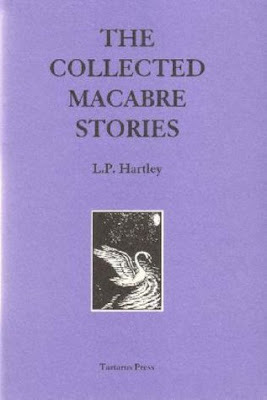 L. P. Hartley: The Collected Macabre Stories (2001)
L. P. Hartley: The Collected Macabre Stories (2001)•
Published on March 02, 2024 13:48
February 23, 2024
Classic Ghost Story Writers: Algernon Blackwood
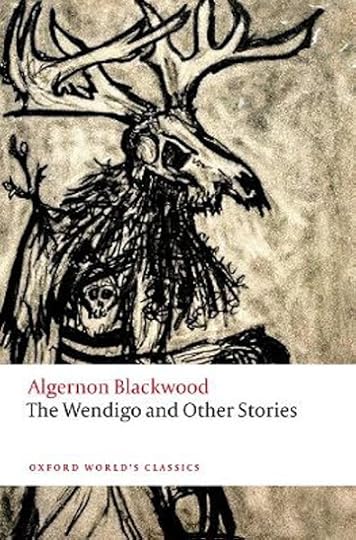 Algernon Blackwood: The Wendigo and Other Stories (2023)
Algernon Blackwood: The Wendigo and Other Stories (2023)'The Wendigo' (1910) remains my favourite story by Algernon Blackwood, and - indeed - one of my favourite horror stories of all time.
I know that H. P. Lovecraft preferred the earlier 'The Willows' (1907), and I certainly acknowledge the wonderfully atmospheric effects achieved by Blackwood in that story, but it just can't compare with the sense of cosmic terror, as well as the intensity of his descriptions of the Northern woods, in 'The Wendigo'.
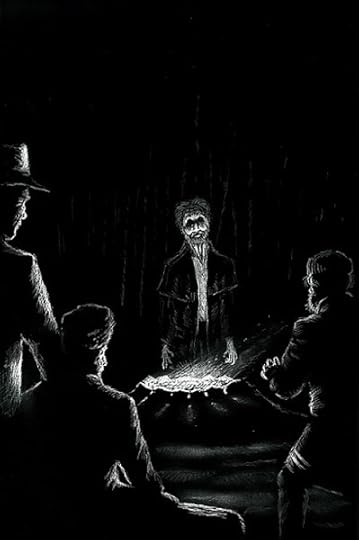 M. Grant Kellermeyer: Classic Horror Blog (2019)
M. Grant Kellermeyer: Classic Horror Blog (2019)"Oh, oh! This fiery height! Oh, oh! My feet of fire! My burning feet of fire!"If you haven't read the story (you can find an online text of it here), those words will sound very strange to you. If you have, they'll be only too meaningful.
But what exactly is a wendigo (or windigo, as it's also called)?
The wendigo is often said to be a malevolent spirit, sometimes depicted as a creature with human-like characteristics, which possesses human beings. It is said to cause its victims a feeling of insatiable hunger, the desire to eat other humans, and the propensity to commit murder. In some representations, the wendigo is described as a giant humanoid with a heart of ice, whose approach is signaled by a foul stench or sudden unseasonable chill.- Wikipedia: WendigoThis is far from Blackwood's description of it as a "moss-eater", with huge misshapen feet from its bounds up into the fiery upper air. In general he is careful to avoid its associations with cannibalism, a perennial problem for many of the Northern Native American tribes, who often ran short of food in winter if the harvest had been bad the year before, and who therefore tended to be accused of acts of cannibalism by missionaries and colonisers (as historian Francis Parkman records in his 1865 account The Pioneers of France in the New World).
Here's a typical Windigo folktale, collected from a Chippewa informant by Lottie Chicogquaw Marsden:
One time long ago a big Windigo stole an Indian boy, but the boy was too thin, so the Windigo didn't eat him up right away, but he travelled with the Indian boy waiting for him till he'd get fat. The Windigo had a knife and he'd cut the boy on the hand to see if he was fat enough to eat, but the boy didn't get fat. They travelled too much. One day they came to an Indian village and the Windigo sent the boy to the Indian village to get some things for him to eat. He just gave the boy so much time to go there and back. The boy told the Indians that the Windigo was near them, and showed them his hand where the Windigo cut him to see if he was fat enough to eat. They heard the Windigo calling the boy. He said to the boy "Hurry up. Don't tell lies to those Indians." All of these Indians went to where the Windigo was and cut off his legs. They went back again to see if he was dead. He wasn't dead. He was eating the juice (marrow) from the inside of the bones of his legs that were cut off. The Indians asked the Windigo if there was any fat on them. He said, "You bet there is, I have eaten lots of Indians, no wonder they are fat." The Indians then killed him and cut him to pieces. This was the end of this Giant Windigo.
 Sophia Cathryn: Wendigo (2022)
Sophia Cathryn: Wendigo (2022)As you can see from the illustration above, Wendigos are generally depicted as being cadaverously thin, ravenously hungry, and prone to eating their own faces and limbs if no other food is available - hence their blood-stained teeth. They can also pass on this curse to others, which may account for the return of the French Canadian guide Défago in altered form at a crucial point in Blackwood's story. They don't always have horns, so it's not necessarily easy to identify them at first.
It's just one of many stories Blackwood set in the wilds of Canada. One of the best of the others is "A Haunted Island" (1899), though "Skeleton Lake" (1906) runs it a close second.
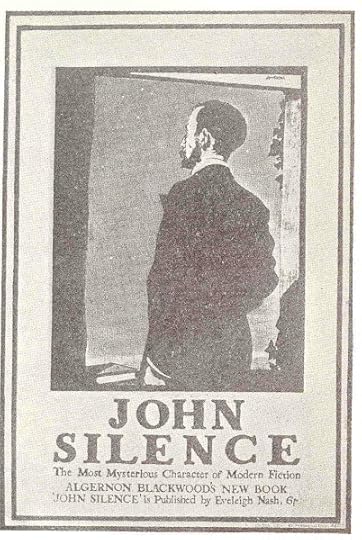 Algernon Blackwood: John Silence, Physician Extraordinary (1908)
Algernon Blackwood: John Silence, Physician Extraordinary (1908)Probably the most impressive of his many collections of mostly fantastic and supernatural stories is John Silence, Physician Extraordinary . John Silence is clearly an heir to Sheridan Le Fanu's Dr. Martin Hesselius, the psychic physician, as well as Bram Stoker's Dr. Abraham Van Helsing, bane of vampires everywhere.
John Silence is, however, more of a spectator than an active participant in the events he witnesses. He's probably at his best in "Secret Worship," set at a haunted boys' school in the Black Forest of Germany, but all of the six stories he figures in (five in the original book; another, "A Victim of Higher Space," collected later) are well worth reading.
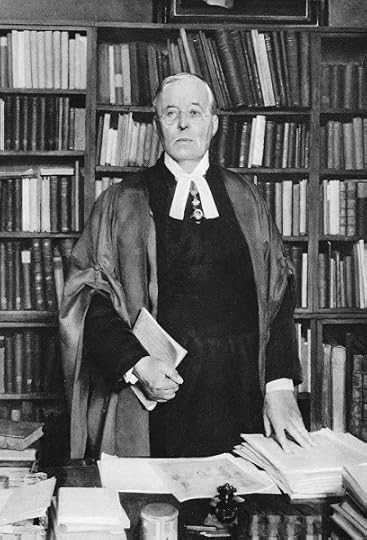 Montague Rhodes James (1862-1936)
Montague Rhodes James (1862-1936)It's true that many of Algernon Blackwood's fictions offend against one or other of the three rules for effective ghost stories laid out by his close contemporary M. R. James in the preface to his own collection More Ghost Stories of an Antiquary (1911):
I think that, as a rule, the setting should be fairly familiar and the majority of the characters and their talk such as you may meet or hear any day. A ghost story of which the scene is laid in the twelfth or thirteenth century may succeed in being romantic or poetical: it will never put the reader into the position of saying to himself, ‘If I’m not very careful, something of this kind may happen to me!’ Another requisite, in my opinion, is that the ghost should be malevolent or odious: amiable and helpful apparitions are all very well in fairy tales or in local legends, but I have no use for them in a fictitious ghost story. Again, I feel that the technical terms of ‘occultism’, if they are not very carefully handled, tend to put the mere ghost story (which is all that I am attempting) upon a quasi-scientific plane, and to call into play faculties quite other than the imaginative.
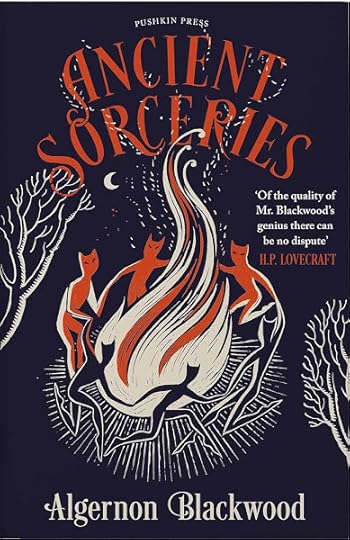 Algernon Blackwood: Ancient Sorceries (2022)
Algernon Blackwood: Ancient Sorceries (2022)the setting should be fairly familiar and the majority of the characters and their talk such as you may meet or hear any day ...Blackwood, by contrast, is fond of setting his stories in Canada, or on the lower reaches of the Danube, or on an island in the Baltic, or in a mysterious small town in France. That is, in fact, part of their attraction. One feels, in almost every case, that he's writing about a place familiar to him, and describing the kinds of characters encountered by him in his adventurous early life.
the ghost should be malevolent or odious ...This is probably true of the Wendigo itself (though that's debatable), but as a general rule, Blackwood's ghosts and occult manifestations of various kinds tend to be largely indifferent to mankind: they operate according to their own rules, for reasons that remain largely obscure to us. The danger comes from the intersection of these otherwordly entities with our own quotidian concerns.
the technical terms of ‘occultism’ tend to put the mere ghost story upon a quasi-scientific plane, and to call into play faculties quite other than the imaginative.It seems probable that James had Blackwood specifically in mind when he wrote this sentence. There's a lot of 'quasi' (or pseudo-) scientific discourse in a good many of his stories, particularly the ones which star John Silence, though in this he was following the example of such classic supernatural novellas as Edward Bulwer-Lytton's "The Haunted and the Haunters; or, The House and the Brain" (1859).
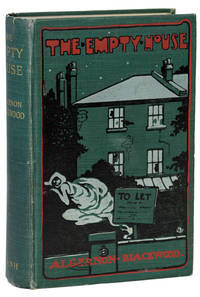 Algernon Blackwood: The Empty House and Other Ghost Stories (1906)
Algernon Blackwood: The Empty House and Other Ghost Stories (1906)There's an expansiveness and range to the best of Blackwood's early stories which far surpasses his later work in the genre, influenced (as it was) by the need to provide stories short enough to broadcast or to fit into the increasingly restrictive demands of magazines.
Despite this, over time he built quite a reputation as a reader of his own stories on radio, and (eventually) on the burgeoning medium of television. But he should really be seen - along with Wilkie Collins, M. R. James and Sheridan Le Fanu - as one of the principal ornaments of the golden age of ghost stories, roughly from the mid-nineteenth century to the outbreak of the First World War.
It's a shame that there's no really comprehensive collection of his work in this genre, uneven in quality though it undoubtedly is. Perhaps the best introduction to his work remains E. F. Bleiler's careful selection, published by Dover in 1973.
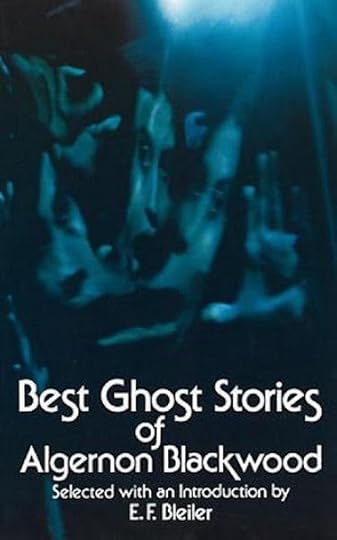 E. F. Bleiler, ed.: Best Ghost Stories of Algernon Blackwood (1973)
E. F. Bleiler, ed.: Best Ghost Stories of Algernon Blackwood (1973)Mind you, the wendigo itself has gone on to become one of the standard 'cryptids' - along with Bigfoot, the chupacabra, the Loch Ness monster, and the Jersey Devil - investigated by proponents of the pseudoscience known as Cryptozoology. It also bears an obvious resemblance to the Slender Man figure in contemporary pop culture.
It has even inspired a couple of feature films, as well as numerous stories, comics, novels and even role-playing games.
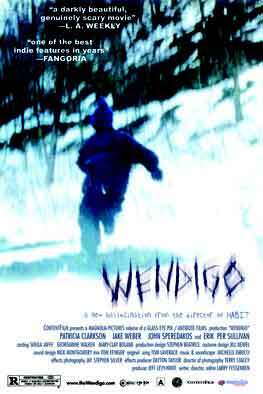 Larry Fessenden, dir. & writ.: Wendigo (2001)
Larry Fessenden, dir. & writ.: Wendigo (2001)•
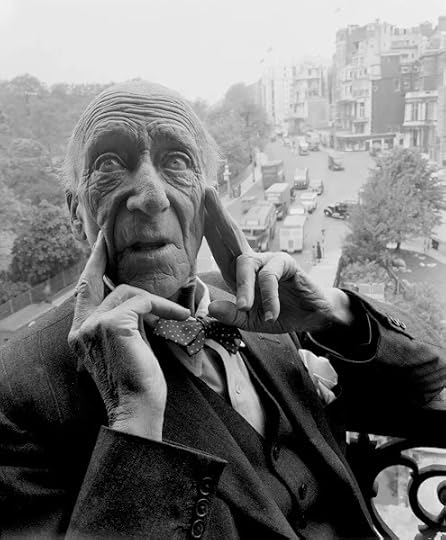 Algernon Blackwood
Algernon BlackwoodAlgernon Henry Blackwood
(1869-1951)
Novels:
Jimbo: A Fantasy (1909)The Education of Uncle Paul (1909)The Human Chord (1910)The Centaur (1911)A Prisoner in Fairyland [sequel to The Education of Uncle Paul] (1913)The Extra Day (1915)Julius LeVallon (1916)Julius LeVallon: An Episode. London: Cassell and Company, Ltd., 1916.The Wave (1916)The Promise of Air (1918)The Garden of Survival (1918)The Bright Messenger [sequel to Julius LeVallon] (1921)Dudley & Gilderoy: A Nonsense (1929)
Children's Books:
Sambo and Snitch (1927)The Fruit Stoners: Being the Adventures of Maria Among the Fruit Stoners (1934)
Plays:
[with Violet Pearn] The Starlight Express. Music by Edward Elgar (1915)[with Violet Pearn] Karma: A Reincarnation Play (1918)[with Bertram Forsyth] The Crossing (1920)[with Violet Pearn] Through the Crack (1920)[with Bertram Forsyth] White Magic (1921)[with Elaine Ainley] The Halfway House (1921)[with Frederick Kinsey Peile] Max Hensig (1929)
Short story collections:
The Empty House and Other Ghost Stories (1906)The Listener and Other Stories (1907)John Silence (1908)John Silence, Physician Extraordinary. 1908. London: Macmillan and Co., Limited, 1912.The Lost Valley and Other Stories (1910)Pan's Garden: A Volume of Nature Stories (1912)Ten Minute Stories (1914)Incredible Adventures (1914)Day and Night Stories (1917)Wolves of God, and Other Fey Stories (1921)Tongues of Fire and Other Sketches (1924)Tongues of Fire and Other Sketches. 1924. London: Herbert Jenkins Limited, n.d.Shocks (1935)The Doll and One Other (1946)
Short Story Selections:
Ancient Sorceries and Other Tales (1927)The Dance of Death and Other Tales (1927)The Dance of Death and Other Stories. 1927. London: Pan Books Ltd., 1973.Strange Stories (1929)Short Stories of To-Day & Yesterday (1930)The Willows and Other Queer Tales. Ed. G. F. Maine (1932)The Tales of Algernon Blackwood (1938)Selected Tales of Algernon Blackwood (1942)Selected Tales: Stories of the Supernatural and Uncanny. 1943. Harmondsworth: Penguin, 1948.Selected Short Stories of Algernon Blackwood (1945)Tales of the Uncanny and Supernatural (1949)Included in: Tales of Terror & Darkness: Part One: Tales of the Uncanny and Supernatural / Part Two: Tales of the Mysterious and Macabre. 1949 & 1967. Spring Books. London: The Hamlyn Publishing Group, 1977.In the Realm of Terror (1957)Selected Tales of Algernon Blackwood (1964)Tales of the Mysterious and Macabre (1967)Included in: Tales of Terror & Darkness: Part One: Tales of the Uncanny and Supernatural / Part Two: Tales of the Mysterious and Macabre. 1949 & 1967. Spring Books. London: The Hamlyn Publishing Group, 1977.Ancient Sorceries and Other Stories (1968)Ancient Sorceries and Other Stories. 1906-1908. Harmondsworth: Penguin, 1974.Best Ghost Stories of Algernon Blackwood. Ed. Everett F. Bleiler (1973)Best Ghost Stories of Algernon Blackwood. Preface by the Author. 1938. Ed. E. F. Beiler. New York: Dover Books, Inc., 1973.The Best Supernatural Tales of Algernon Blackwood. Ed. Felix Morrow (1973)The Best Supernatural Tales of Algernon Blackwood. 1929. Introduction by Felix Morrow. New York: Causeway Books, 1973.Tales of Terror and Darkness (1977)Tales of Terror & Darkness: Part One: Tales of the Uncanny and Supernatural / Part Two: Tales of the Mysterious and Macabre. 1949 & 1967. Spring Books. London: The Hamlyn Publishing Group, 1977. Tales of the Supernatural. Ed. Mike Ashley (1983) The Magic Mirror. Ed. Mike Ashley (1989) The Complete John Silence Stories. [with "A Victim of Higher Space"]. Ed. S. T. Joshi (1997) Ancient Sorceries and Other Weird Stories. Ed. S. T. Joshi (2002) Algernon Blackwood's Canadian Tales of Terror. Ed. John Robert Colombo (2004) Ancient Sorceries and Other Stories (2022)The Wendigo and Other Stories. Ed. Aaron Worth. Oxford World's Classics. Oxford: Oxford University Press, 2023.
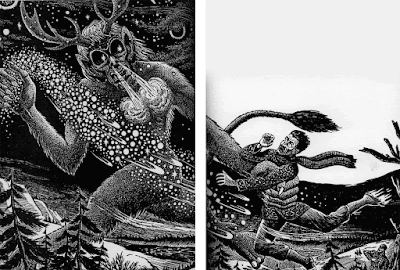 Matt Fox: Illustration for The Wendigo (2015)
Matt Fox: Illustration for The Wendigo (2015)•
Published on February 23, 2024 13:42
February 16, 2024
Troy Town
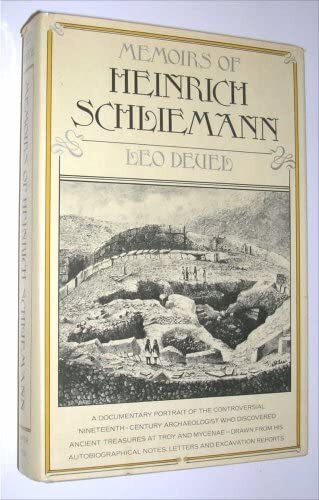 Leo Deuel, ed.: Memoirs of Heinrich Schliemann (1978)
Leo Deuel, ed.: Memoirs of Heinrich Schliemann (1978)Troy Town is the traditional name for many of the mazes and earthworks of England. This may refer to the tricky way in which the walls of Troy were constructed, full of dead-ends and blind corners to baffle an enemy. Or, alternatively, it may just because the razing of the city of Troy, leaving only a few mounds of earth behind, has seen ever since as emblematic of any such scene of utter devastation.
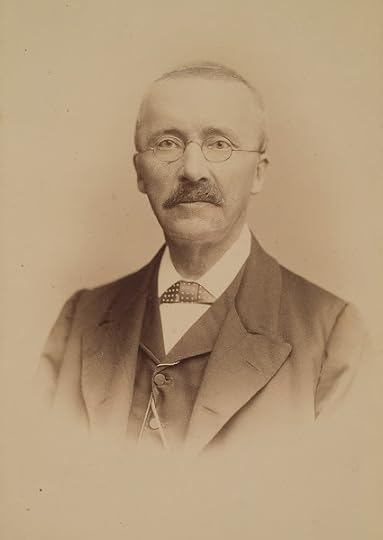 Heinrich Schliemann (1821-1890)
Heinrich Schliemann (1821-1890)Recently I've been reading a compilation of autobiographical pieces by Heinrich Schliemann, the (so-called) discoverer of Troy. Schliemann was a bit of a con-man, an inveterate exaggerator, and a self-promoter on a Barnum-like scale, but there was also a touch of genius in him. His instincts often led him to the right place at the right time when others' well-reasoned arguments led them astray.
His initial excavations at Hisarlik, the Anatolian hillock which he believed to be the site of Homer's Troy, were catastrophic. He dug a huge trench through the centre of the mound, in the process destroying many of the remains which might later have helped him and others reconstruct crucial layers of the ancient city. To some extent he made up for this in subsequent years as he learnt more and more about archaeological method, but the fact is that he probably did more harm than good as an actual excavator.
He was, however, largely responsible for the discovery of a hitherto unsuspected civilisation. Whether you call it Minoan or Mycenaean, the existence of an advanced, sophisticated culture in the Eastern Mediterranean long before the Classical Age, was unsuspected before he began his explorations in the 1870s. In the process, Schliemann whipped up a frenzy of enthusiasm not just for treasure hunting but for scientific archaeology in the Europe of his time.
He remains an ambiguous figure, but his contribution to the debate over the historicity of Homer's Troy is undeniable.
 Michael Wood: In Search of the Trojan War (1985)
Michael Wood: In Search of the Trojan War (1985)But why should there even be such a debate? Is there anything intrinsically implausible in the story of Troy? Whether the war was fought because of the abduction of Helen of Sparta by the Trojan Prince Paris, as Homer claimed, or over trade-routes through the Bosphorus, as the Greek historian Herodotus preferred to tell it, the basic plotline of a destructive conflict between west and east hasn't changed that much over the past three millennia.
 Al Jazeera: Jabalia refugee camp, Gaza Strip (31/10/23)
Al Jazeera: Jabalia refugee camp, Gaza Strip (31/10/23)As I write, Netanyahu's soldiers are invading hospitals and exulting as they blow up mosques. They film themselves doing it, in fact. Shades of Ajax and Achilles looting and desecrating their enemies' bodies!
 CNN: Israeli soldier films himself blowing up a mosque (17/2/24)
CNN: Israeli soldier films himself blowing up a mosque (17/2/24)Has anything changed in the intervening period? The weapons have got more powerful, and the propaganda easier to slipstream around the world. Otherwise, it's business as usual for humanity: hatred, lies, contempt for anyone you can define as 'Other', on whatever flimsy pretext you can find.
Perhaps in another few hundred years archaeologists will be speculating on the various layers of pulverised debris they find in their excavations in ancient Canaan / Judea, modern Israel / Palestine. Maybe they'll conclude that the whole idea of a war was just a myth: the subsequent layers of radioactive waste have wiped out any sense of whatever civilisation (if any) proceeded the bombardment.
For the moment, though, women and children are dying in thousands. It seems impossible to exaggerate the terror and privations currently being suffered by the people of Gaza: 27,708 is this morning's total of dead. Just stop. How can that be so impossible to achieve? Have we learned nothing at all from all those previous massacres?
 Paul Klee: Angelus Novus (1920)
Paul Klee: Angelus Novus (1920)A Klee painting named Angelus Novus shows an angel looking as though he is about to move away from something he is fixedly contemplating. His eyes are staring, his mouth is open, his wings are spread. This is how one pictures the angel of history. His face is turned toward the past. Where we perceive a chain of events, he sees one single catastrophe which keeps piling wreckage upon wreckage and hurls it in front of his feet. The angel would like to stay, awaken the dead, and make whole what has been smashed. But a storm is blowing from Paradise; it has got caught in his wings with such violence that the angel can no longer close them. The storm irresistibly propels him into the future to which his back is turned, while the pile of debris before him grows skyward. This storm is what we call progress. - Walter Benjamin, Theses on the Philosophy of History (1940)
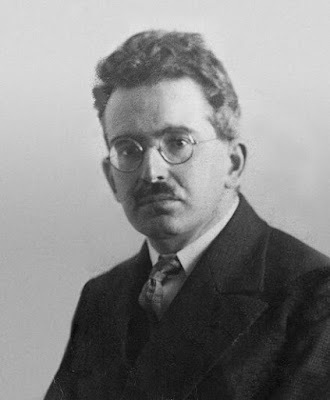 Walter Benjamin (1892-1940)
Walter Benjamin (1892-1940)
Rear WindowA friend of mineset up a camerain the back of her carand drove down the hillto the beach and backart filmscoffed her boyfriendand yetthere was somethingso strange in the wayit bucked and leaptas it recorded the unchanging mountainsbehindwith no hint of the wild sea in frontBenjamin’s angel of historydoes thatsweeps onlooking backunable to helpas the rubble and graves pile upthey used to project it at rock concerts(8/10/22-17/2/24)
 Demonstration in London (14/10/23)
Demonstration in London (14/10/23)CEASEFIRE NOW!
Published on February 16, 2024 12:53
January 18, 2024
Who the heck is Solar Pons?
 August Derleth: The Solar Pons Omnibus (1982)
August Derleth: The Solar Pons Omnibus (1982)August Derleth. The Solar Pons Omnibus. 2 vols. Ed. Basil Copper. Drawings by Frank Utpatel. Foreword by Robert Bloch. A Mycroft & Moran Book. Sauk City, Wisconsin: Arkham House Publishers, Inc., 1982.
The other day I ran across this strange pair of volumes in a local secondhand bookshop. Solar Pons? Who on earth could that be? I was, of course, familiar with the name of the author, August Derleth, from my extensive reading of the late H. P. Lovecraft, whose literary executor he was ... or claimed to be.
"Solar Pons", though ... "pons" is the Latin word for bridge, and "solar" for all things pertaining to the sun. Was the intention, perhaps, to suggest some kind of Bifrost-like bridge leading to enlightenment?
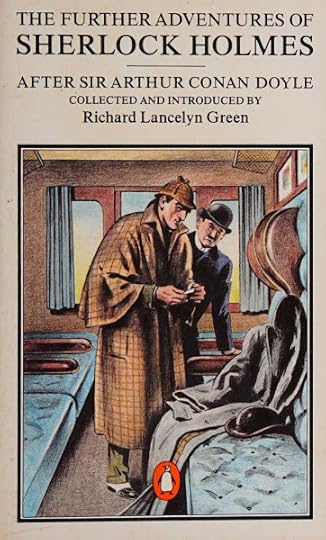 Richard Lancelyn Green, ed.: The Further Adventures of Sherlock Holmes (1985)
Richard Lancelyn Green, ed.: The Further Adventures of Sherlock Holmes (1985)"God said: Let Sherlock be! and all was light ..."
- John Masefield
But enough of this trifling. "Solar Pons" is an avatar of "Sherlock Holmes", as I knew already from a scatter of references here and there. He isn't included in Richard Lancelyn Green's classic anthology The Further Adventures of Sherlock Holmes, as that collection is confined solely to stories using the original names.
But then that was Derleth's original intention, too:
On hearing that Doyle did not plan to write more Sherlock Holmes stories, the young Derleth wrote to him, asking permission to take over the series. Doyle graciously declined, but Derleth, despite having never been to London, set about finding a name that was syllabically similar to "Sherlock Holmes," and wrote his first set of pastiches in 1928, which were published in The Dragnet Magazine in 1929.- Wikipedia: Solar Pons
•
 Elementary (7 series: 2012-2019)
Elementary (7 series: 2012-2019)We've certainly become rather accustomed to updated film and television versions of Sherlock Holmes over the past couple of decades.
 Sherlock (4 series: 2010-2017)
Sherlock (4 series: 2010-2017)Sherlock Holmes (2 films: 2009 & 2011)
 House, M.D. (8 series: 2004-2012)
House, M.D. (8 series: 2004-2012)And if you're tempted to query the presence of Dr. House in this grouping, what can one say of a man whose best friend is called "Wilson" (= Watson), and who's segued from a consulting detective to a consulting diagnostician? In any case, I've canvassed that subject extensively here.
Of the other three pictured above: Robert Downey Jr's steampunk version of Holmes; Benedict Cumberbatch's excessively cerebral, rather Alan Turing-like incarnation of the great man; and Jonny Lee Miller's New York-based junkie impersonation of the detective, I'm rather surprised to put on record here that at present it's Jonny Lee Miller who scoops the prize for me.
No doubt that has something to do with a serendipitous pairing with the dazzling Lucy Liu, definitely the most impressive Watson to date - so much better than Martin Freeman's petulant misery-guts, or even Jude Law's no-nonsense action man. In any case, for those of you who haven't seen it, Elementary is a very satisfying exercise in suspension of disbelief.
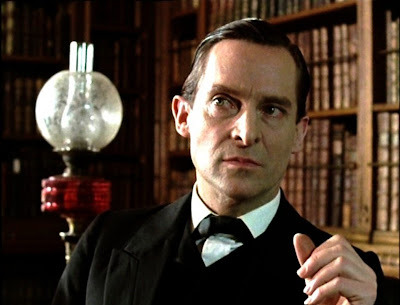 Jeremy Brett as Sherlock Holmes. (4 series: 1984-1994)
Jeremy Brett as Sherlock Holmes. (4 series: 1984-1994)So what's next? Sherlock Holmes on ice? With an eventual total of 154 episodes, Jonny Lee Miller is now (according to Wikipedia) "the actor who has portrayed Sherlock Holmes the most times in television and/or film, overtaking Jeremy Brett (with 41 television episodes) and Eille Norwood (with 47 silent films)."
It may, however, interest you to know that Derleth wrote "more stories about Pons than Conan Doyle did about Holmes." Doyle wrote four novels and 56 short stories about Holmes, whereas Derleth wrote more than seventy stories (plus a couple of novels) about Pons.
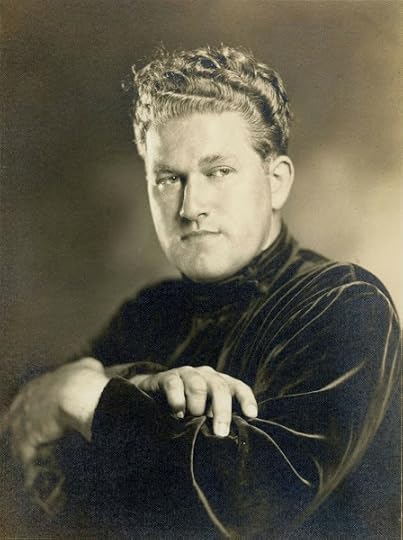 August Derleth (1909-1971)
August Derleth (1909-1971)There are obvious similarities between the two. Pons lives at 7B Praed Street; Holmes at 22B Baker Street. Pons' companion in crime is called Dr. Parker; Holmes's Dr. Watson. Pons' landlady is Mrs. Johnson; Holmes's Mrs. Hudson. Pons' Inspector Jamison stands in for Holmes' Inspector Lestrade - et al. Each has a group of "Irregulars" who assists him in scouring the labyrinthine warrens of Old London Town ...
There are, however, significant differences as well. The Pons stories are set in the 1920s and 30s, starting just after the First World War. The Holmes stories are set some forty years earlier, in the twilight years of the Victorian era (with one significant flash-forward, in "His Last Bow," to a piece of espionage during the Great War). Pons frequently mentions his "great predecessor," and even comments on the resemblance of some investigation or another to once conducted by Holmes himself.
Nor are the other characters precisely interchangeable. Dr. Parker is a far more peevish and irritable companion than Watson, and there is far less sniping at the official police in the Pons adventures. Nor is Mrs. Johnson's sang-froid at the goings-on of her unusual tenant nearly as tenuous as Mrs. Hudson's.
Pons lives in a rather more cushioned fantasy world than his progenitor Holmes. He also encounters other heroes of the time, such as Sax Rohmer's Dr. Fu Manchu, Agatha Christie's Poirot, Somerset Maugham's Ashenden, and even Leslie Carteris's Saint on various occasions, which might have the deleterious effect of breaking the fourth wall, but which nevertheless provides innocent amusement to fans such as myself.
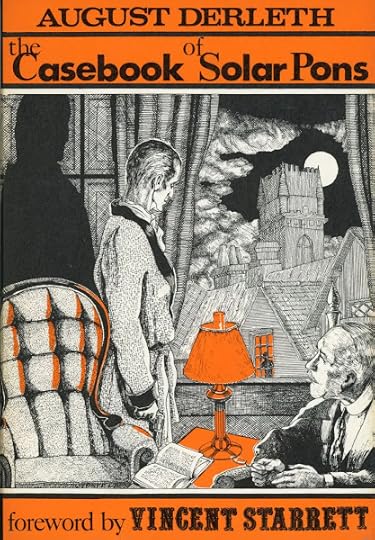 August Derleth: The Casebook of Solar Pons (1965)
August Derleth: The Casebook of Solar Pons (1965)But are the stories themselves any good? Well, that's debatable. They're surprisingly readable. Pons is seldom at a loss when it comes to solving the neat little puzzles that present themselves to him (more often than not by an attractive young lady who "instinctively" addresses herself to him despite the presence in the room of the gloomy Dr. Parker). He often repeats classical Holmesian adages such as "the game's afoot", and is seldom seen without a deerstalker - an item of clothing invented by Doyle's illustrators rather than by the author.
Here's a list of Derleth's original collections:"In Re: Sherlock Holmes": The Adventures of Solar Pons (1945)The Memoirs of Solar Pons (1951)The Return of Solar Pons (1958)The Reminiscences of Solar Pons (1961)The Casebook of Solar Pons (1965)A Praed Street Dossier (1968)Mr. Fairlie's Final Journey (1968)The Chronicles of Solar Pons (1973)All of the stories in these books, including the novel Mr. Fairlie's Final Journey, are included in The Solar Pons Omnibus (1982), pictured above.
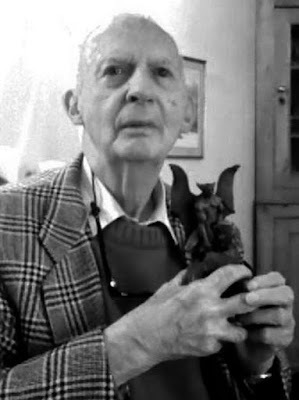 Basil Copper (1924-2013)
Basil Copper (1924-2013)The story doesn't finish there, though - not by a long chalk. After Derleth's death in 1971, the character was revived by British horror and detective writer Basil Copper (author of Necropolis , among many other titles). He went on to write a further eight volumes of Solar Pons adventures, initially with the cooperation of Derleth's estate, but later on his own:The Dossier of Solar Pons (1979)The Further Adventures of Solar Pons (1979)The Secret Files of Solar Pons (1979)The Uncollected Cases of Solar Pons (1979)The Exploits of Solar Pons (1993)The Recollections of Solar Pons (1995)Solar Pons Versus The Devil’s Claw (2004)Solar Pons: The Final Cases (2005)Most challenging of all to true believers, however, was his editing of The Solar Pons Omnibus. As well as breaking the continuity of Derleth's original volumes into approximate chronological order (as in William Baring-Gould's similarly controversial Annotated Sherlock Holmes), Copper, an Englishman, also "corrected" faults of orthography and idiom in the stories themselves! Not very assiduously, it must be said, given the number of solecisms they still include.
 August Derleth: The Original Text Solar Pons Omnibus Edition (2000)
August Derleth: The Original Text Solar Pons Omnibus Edition (2000)As a result, The Original Text Solar Pons Omnibus Edition was published in 2000 by Mycroft & Moran. It restores the original text as it was before Basil Copper's edits, and includes - as well as the six collections and one novel in order, the full text of A Praed Street Dossier (1968), as well as The Final Adventures of Solar Pons (1998).
To the 71 canonical stories by Derleth included in the 1982 Solar Pons Omnibus, then, one should add the following supplementary publications:The Unpublished Solar Pons (1994)The Final Adventures of Solar Pons (1998)The Dragnet Solar Pons et al.: Original Pulp Magazine and Manuscript Versions (2011)The Novels of Solar Pons: Terror Over London and Mr. Fairlie's Final Journey (2018)The Apocrypha of Solar Pons (2018)The Arrival of Solar Pons: Early Manuscripts and Pulp Magazine Appearances of the Sherlock Holmes of Praed Street (2023)The last in the list (it should be stressed) is simply a revised and expanded version of The Dragnet Solar Pons.
So what is one to conclude from all this? That some people have far too much time on their hands? That the idea of fan fiction goes back far further in time than one might have supposed (as far back as Cervantes in the 17th century, at least ...) That the Transatlantic battles between American Sherlockians and English Holmesians now have their echo in the battle between these two warring omnibuses? (Or is the correct term omnibi? Basil Copper would know ...)
If you're curious to know more about Solar Pons and his adventures, I strongly recommend the website, http://solarpons.com/, devoted to him and his adventures. Its creator, Bob Byrne, who is clearly a pop culture fanatic after my own heart, has also written a good introductory article, "The Public Life of Sherlock Holmes: Meet Solar Pons" (17/11/2014), on his blog Black Gate: Adventures in Fantasy Literature .
For myself, I certainly don't regret purchasing Basil Copper's handsomely bound and curated collection of the Solar Pons mysteries - not to mention the many hours I've spent poring over its contents. There are only 60 actual Holmes stories to read and re-read, after all, and even a somewhat watered-down version of his mythos such as this can be very entertaining.
I'm also trying very hard to tell himself that I don't need the (even rarer) Original Text Solar Pons Omnibus Edition, but if anyone has a copy for sale at a reasonable price, you could do worse than drop me a line in the comments section below ... There's no fool like a bibliophile, as the saying has it, and I have to plead guilty to the imputation.
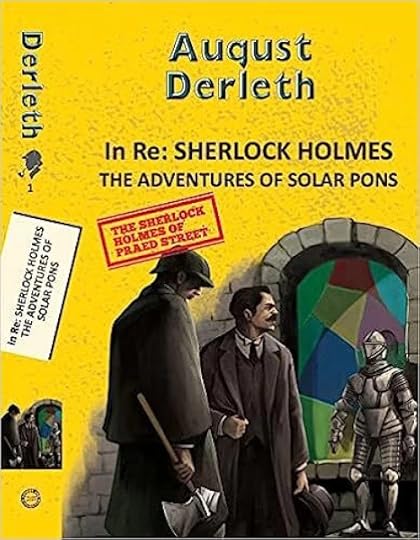 August Derleth: In Re: Sherlock Holmes: The Adventures of Solar Pons (1945)
August Derleth: In Re: Sherlock Holmes: The Adventures of Solar Pons (1945)•
Published on January 18, 2024 11:42



